| |||||||
 |
| Search this Thread |  758,947 views |
| | #1 |
| Team-BHP Support  | Maruti Dzire : Official Review The Maruti Dzire is on sale in India at a price of between Rs. 5.43 - 9.39 lakhs (ex-Delhi). What you'll like: • A great looking Dzire…and an all-rounder too • Smart packaging! Spacious, stylish & practical cabin. Boot has grown to 378 litres • Sweet petrol & efficient diesel. AMT available with both engines for just 47k extra • Suspension offers a compliant ride & neutral on-road behaviour • Impressively equipped (LED headlamps + DRLs, reversing camera, Apple & Android touchscreen ICE…) • Dual airbags, ABS & ISOFIX child seat mounts are standard across all variants • Maruti's widespread service network, excellent after-sales support & fuss-free ownership experiences What you won't: • “Z” trims are pricey. The top-end diesels & automatics cost a million bucks! • Old 1.3L diesel is nowhere as competent as the Ford & VW 1.5L diesels • AMT, although improved, can’t match conventional ATs on smoothness & speed. Still gets jerky • You can buy proper ATs (e.g. torque-converter or DCT) for the same $$$ as the Dzire AMT • 163 mm of ground clearance & small 37-liter fuel tank do raise concerns • Some misses (auto-dimming IRVM, skinny 165 mm tyres on L & V variants, smaller spare tyre on the Z trims...) • Waiting periods have already begun. They currently stretch up to 3 months Last edited by GTO : 11th July 2017 at 09:00. |
| |  (68)
Thanks (68)
Thanks
 |
| The following 68 BHPians Thank Aditya for this useful post: | abhijeet080808, abhinav.s, aeroamit, ARAY, arun_josie, AutoIndian, Avikbrio, bhpfaninblr, blackwasp, CarguyNish, carrazy, cbatrody, chinmaypillay, dailydriver, darklord, deetjohn, doxinboy, drhoneycake, dZired, espraveen, Gannu_1, Grand Drive, GTO, Iksvaku, iliketurtles, InControl, Jaggu, Karthik Chandra, Keynote, Leoshashi, libranof1987, lovetorque, lurker, mi2n, mpksuhas, Mr.Boss, Nohonking, NPV, phoenixash, phynix123, Ponbaarathi, procrj, Rajeevraj, Rambo-RS, RavenAvi, samabhi, sandx, SatishBisht, sdp1975, shipnil, silverado, Simhi, Sip, sri_tesla, swiftnfurious, theexperthand, Torino, TorqueTwist, uday.ere, vb-saan, VeluM, vibbs, Vid6639, Viju, Vik0728, vikred, y2ksrs, zaveed |
| |
| | #2 |
| Team-BHP Support  | Review Index: Exterior Last edited by GTO : 11th July 2017 at 09:10. |
| |  (16)
Thanks (16)
Thanks
 |
| The following 16 BHPians Thank Aditya for this useful post: | arun_josie, CarguyNish, dZired, Gannu_1, GTO, Leoshashi, NPV, phoenixash, RavenAvi, SatishBisht, Sudeep_Kimster, theexperthand, uday.ere, vb-saan, vikred, y2ksrs |
| | #3 |
| Team-BHP Support  | Exterior  In the sub-4 meter sedan segment, Maruti's Swift Dzire has been a dominant player. Maruti had launched the first-generation Swift Dzire in India back in 2008. The second-gen model was introduced in 2012, while a minor cosmetic facelift came in 2015. Throughout its lifetime, the car has been leading its segment by a fairly wide margin. The automaker claims to have sold over 13.8 lakh units of the Dzire till date and it currently boasts of a market share of ~50% among compact sedans. In 2016, the car sold at an average of 16,840 units every month!! In fact, it is not just successful in its segment, but has also been the country's highest-selling sedan for the last three years. At times, it has also toppled the Alto as Maruti's highest selling car. You can understand the pressure on Maruti's engineers when designing its next-gen replacement. The Dzire, which is now in its third generation, has big shoes to fill. For a start, the car has dropped the Swift moniker, an indication that this best-seller surely has its own identity now. Again, it may be noted that in what is a first, the new-gen Dzire is being launched before the new-gen Swift (which is expected to be launched later in the year). What is great to know is that the new car is priced just slightly higher than the outgoing model, considering the additional safety features that are available as standard. Among the engines, Maruti is charging a little over Rs. 1 lakh more for the diesel engine over the petrol mill. Another important point to note is that the Dzire comes with an AMT automatic on both engines (~47k premium over the MT). The earlier car was available with a torque converter automatic transmission, only with the petrol engine. The AMT is available on the mid (V) and top (Z & Z+) trim levels of the car, which is a welcome change from Maruti's regular policy of offering an automatic transmission only on the middle variants. That said, the AMT gearbox, which is cheaper than conventional automatic transmissions, should have ideally made the Dzire substantially cheaper than its rivals, but surprisingly, it hasn't. The car is priced similarly to its rivals. In fact, in some cases, you can get cars with more accomplished automatic gearboxes at similar or just slightly higher prices. Overall, we can say that the Dzire's pricing is at par with its rivals. It is evident that the target market has found the car's pricing to be acceptable, going by the 50,000 bookings up already. Moderator Vid6639 shares "the Maruti dealer in Bangalore had a queue for people coming to book the Dzire. They have actually implemented a token system for bookings"! When was the last time you heard of a bank-like token system? As you would expect, there is a waiting period of 3 months for the car at present. On the road, wherever I drove, people turned around to check the car out. Such is the mass market appeal of the Dzire. 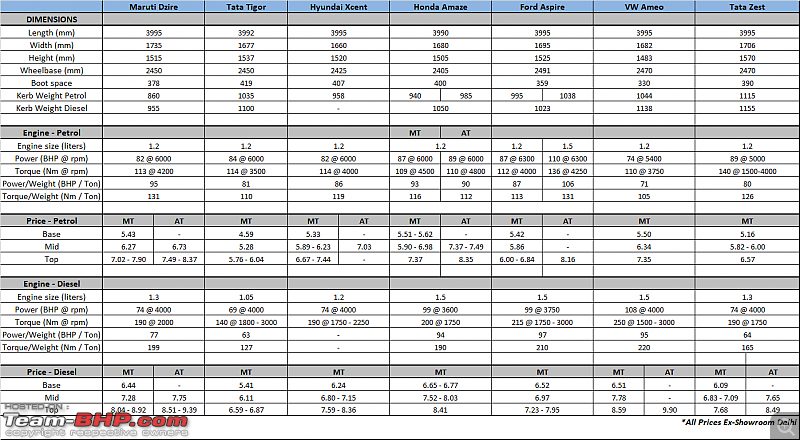 At 3,995 mm, the new Dzire is just as long as its predecessor. However, at 1,735 mm, it is 40 mm wider than the old car. It is also the widest sub-4 meter sedan in the country now. Measuring 1,515 mm in height, it is 40 mm lower than the outgoing car. Its wheelbase of 2,450 mm is 20 mm longer. At 163 mm, the ground clearance has been reduced by 7 mm compared to the old car. It is also the lowest among all its rivals. We must remember that this is the unladen ground clearance of the car. Until now, the Dzire was always considered to be a weird-looking compact sedan with a poorly integrated boot. The new car changes that as the boot is far better integrated. While it is still not as graceful as a regular sedan, the overall design is much more aesthetically appealing and mature than before. While the new Dzire looks contemporary, Maruti has clearly played it safe with the styling. Most people will like it, no one will detest it (a car like the Tata Tigor will polarize opinions more). At the front, there is a large, hexagonal grille with a thick chrome border, black horizontal slats and a prominent chrome 'S' badge in the center. The chrome border is thickest at the top. Like the old car, the new Dzire gets sweptback headlamps, but they are more angular than before. The headlamp cluster houses L-shaped LED DRLs and LED headlights (a first for the segment) housed in projectors. Sadly, these are available only on the top end Z+ trim and the lower variants have to make do with regular halogen bulbs housed in boring reflectors (no LED DRLs either). There is a new clamshell bonnet and round foglamps with long L-shaped chrome inserts. While the front is more mature-looking than before, the general feeling is that there is an excessive application of chrome at the front. Viewed from the side, it seems like a more proportionate sedan than the outgoing car. No longer does the boot look like it was added onto a hatchback as an after-thought. The design is clean without any cuts and creases. There is no use of chrome either, except on the window sills. Maruti has also equipped the car with very good-looking precision cut 15-inch alloy wheels. At the rear, there is a pair of LED tail-lamp clusters (indicator & reversing lights are regular halogen) with a thick chrome strip running between them. This strip, coupled with the chrome badges scattered all over the boot lid, gives the impression of too much chrome again. There is little doubt that the mass market loves its chrome; most BHPians though might have liked it toned down. The fit & finish are good with uniform panel gaps all over. The Dzire is based on the HEARTECT platform, which underpins the Baleno as well. With the lightweight platform, it weighs just 860 - 990 kg depending upon the variant, making it the lightest sedan in India. For the record, the older car weighed 935 - 1045 kg. As expected, the low weight is reflected in the build of the car. The doors, bonnet and boot are very light and there is a bit of flex when the sheet metal is pressed with your thumb. Overall build quality is however satisfactory - it’s not Euro solid, but it feels better than Maruti’s usually light + flimsy builds. The car also uses 36% high tensile steel, compared to 20% for the old car, making it stronger and more rigid. The Dzire is available in 6 paint shades and the paint job is up there with the best of Maruti's offerings. Coming to safety, the Dzire gets two airbags, ABS + EBD with brake assist, ISOFIX child seat mounts and seatbelt pretensioners with load limiters as standard. While the car has not been crash tested by NCAP or other independent bodies, Maruti claims that it is compliant for Indian pedestrian safety, side-impact and offset crash regulations ahead of the set timeline. The fascia is dominated by a large, chrome-lined grille that is flanked on both sides by LED projector headlamps with daytime running lights (DRLs). Some BHPians have commented that the grille gives the car a resemblance to the erstwhile HM Ambassador:  The rear has a new boot lid with a sharp lip on the top edge. The number plate housing continues to be located in the center, with a prominent chrome bar running above it: 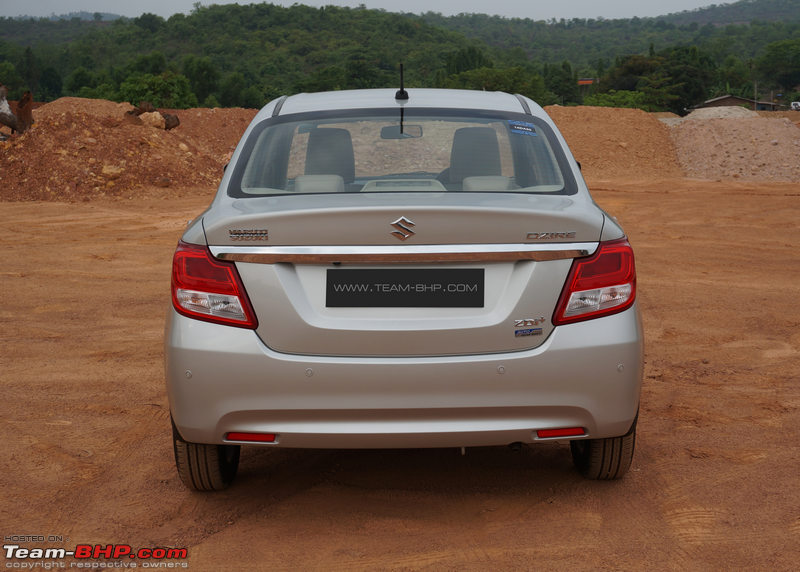 Viewed from the side, the design looks a lot more proportionate than the older versions of the Dzire. The boot is far better integrated than before. No longer does it look like it was added onto a hatchback as an after-thought. Overhangs are short and the car gets a vertical nose. Like most other contemporary designs, notice how the shoulder line's height has gone up: 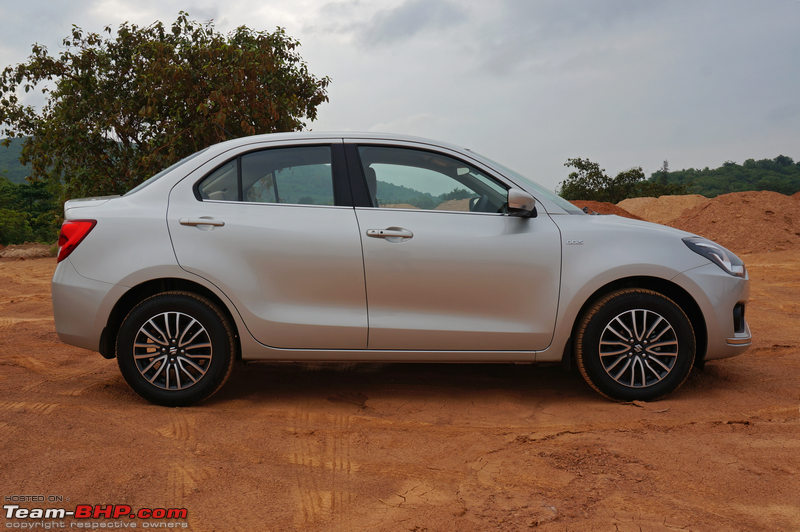 The new Dzire's length remains the same as the old car's at 3,995 mm. However, at 1,735 mm, its width has been increased by 40 mm and at 2,450 mm, the wheelbase has been upped by 20 mm. That said, it is still not as long as the Baleno's (2,520 mm). On the other hand, the ground clearance at 163 mm is 7 mm less than the predecessor and the height (1,515 mm) has been reduced by 40 mm:  While the new Dzire looks more contemporary, Maruti has clearly played it safe with the styling. There are no strong character lines anywhere and the wheel arches are not excessively flared either. Because the number plate is not fully supported from behind (lower half is hanging), I think we'll be seeing some Dzires running around with broken plates: 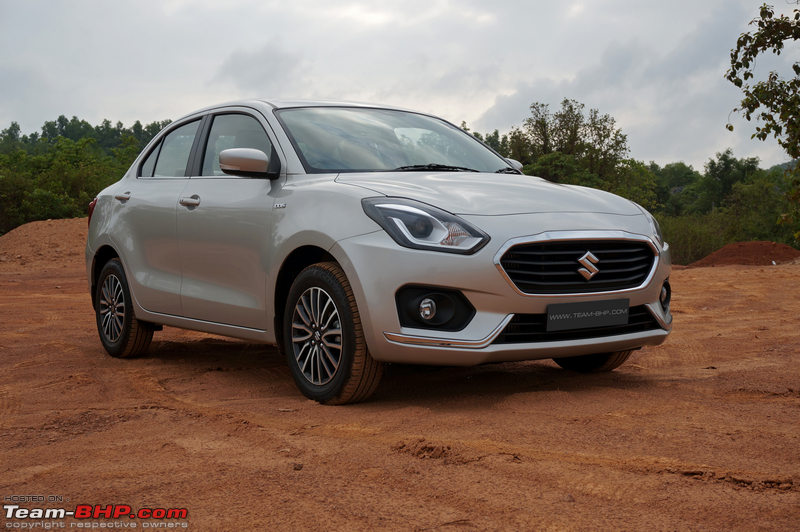 The 3rd-generation is surely the best looking Dzire till date. Even from this angle, unlike some other sub-4 meter sedans, it is a good car to look at: 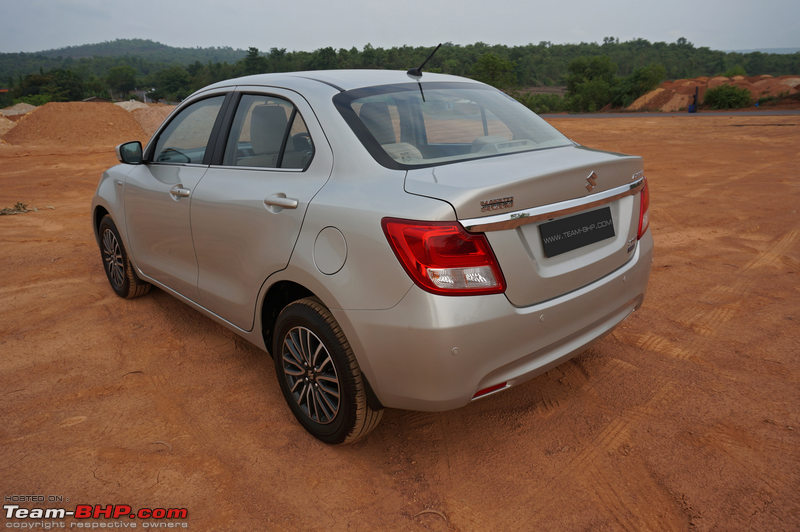 Top-end variants are equipped with automatic LED projector headlamps, along with LED U-shaped daytime running lights (DRLs) on the lower edge of the assembly. Also notice the chrome eyelid above the projector housing: 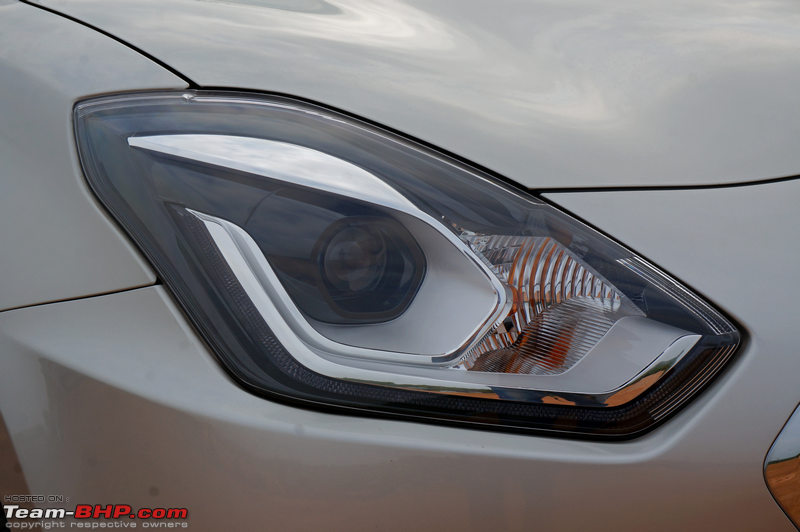 A look at the headlamp cluster with all the lights in action. Yep, the headlamps have the 'follow me home' and 'lead me to vehicle' features. Remember, these functions work only when the headlamps are in 'auto' mode. Turn-indicators are located on the inner portion of the headlamp cluster. DRLs are on all the time; switching on the pilot lamps makes them dim a little: 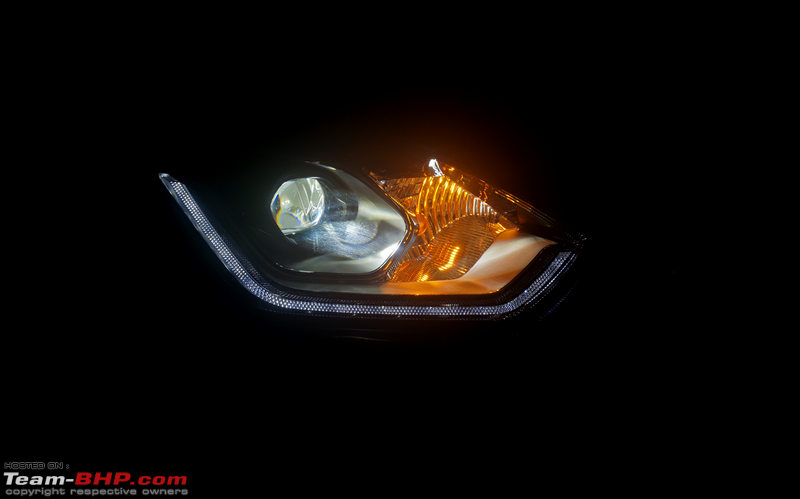 LED DRLs are bright and prominent, even under sunlight. They lend the car good road presence:  Large hexagonal grille gets a chrome border, horizontal slats and a BIG "S" in the center. The chrome strip is thickest on top: 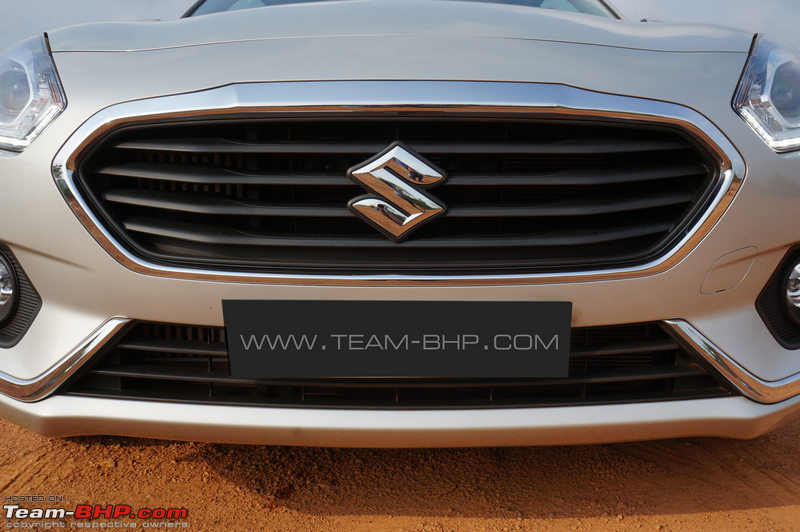 Diesel's vertically mounted intercooler sitting next to the radiator is visible through the grille: 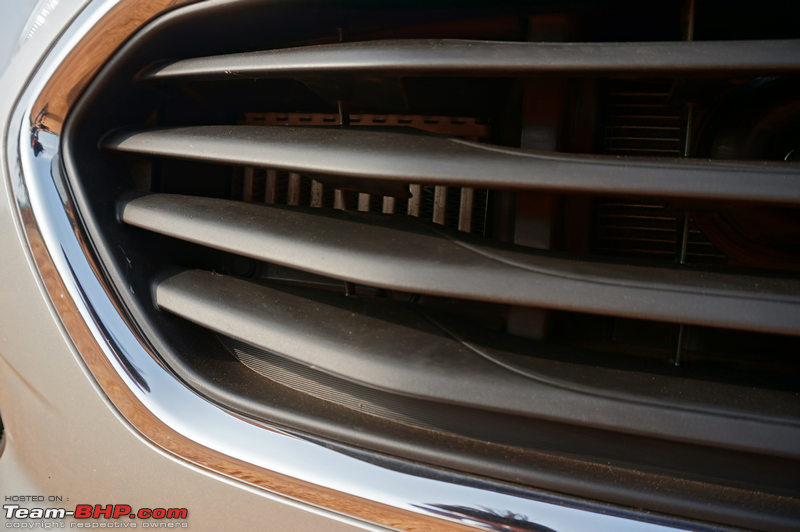 Wide air dam gets L-shaped inserts at both ends. Excessive chrome at the front, no? 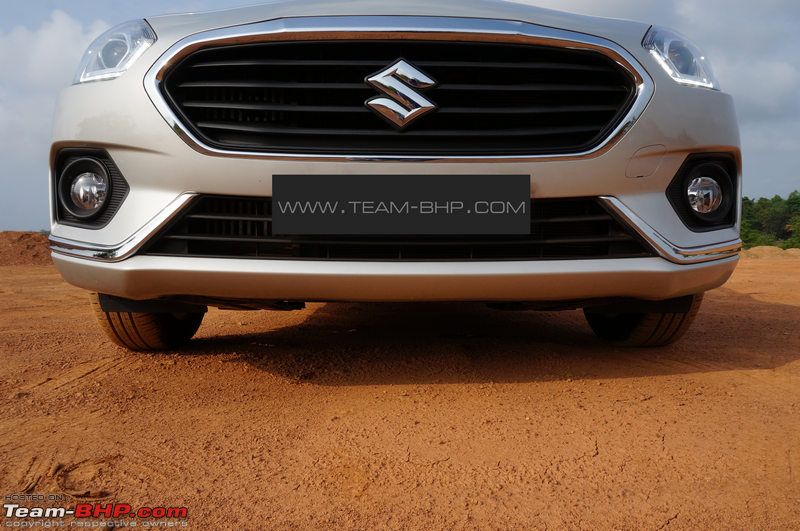 Round foglamps do a fair job of lighting up the edge of the road. They get black housings with horizontal slats for detailing: 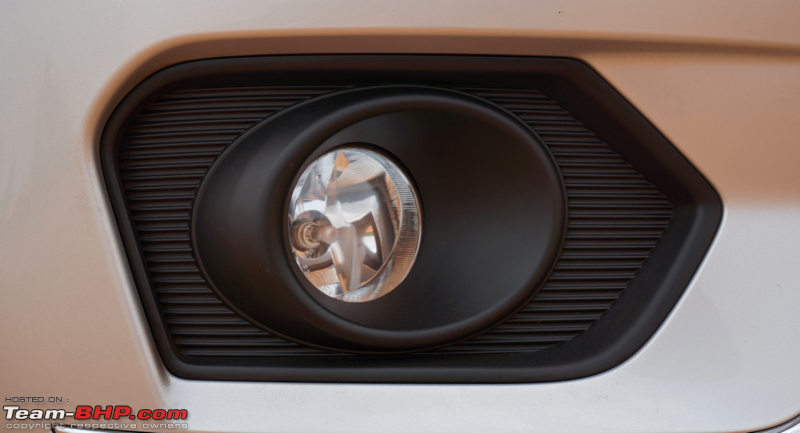 Shockingly, no underbody protection at all! Not even a plastic cover below the engine. Couple that with the unladen ground clearance of just 163 mm, and it does get concerning: 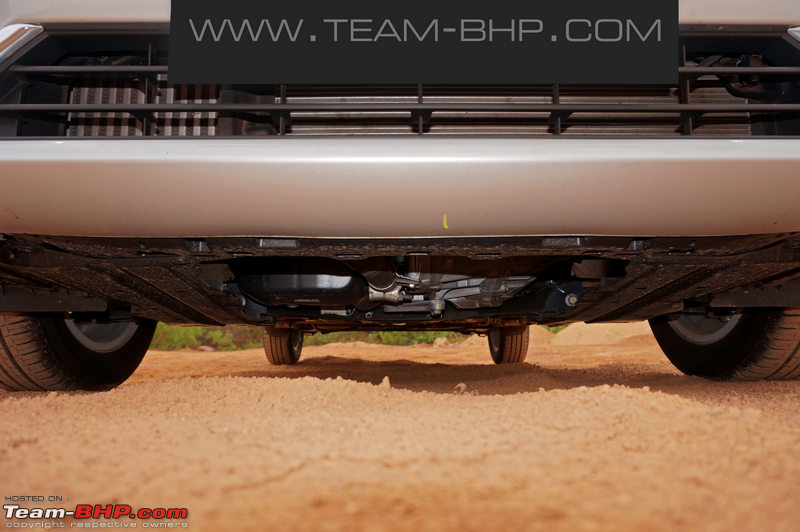 New clamshell bonnet has a smooth design with no prominent cuts or creases. The complete nose area is actually the front bumper  . The bonnet ends fairly above the front grille. As a result, in case of a mild forward collision, there are lesser chances of denting the sheet metal of the car: . The bonnet ends fairly above the front grille. As a result, in case of a mild forward collision, there are lesser chances of denting the sheet metal of the car: Windshield washers are well concealed under the bonnet: 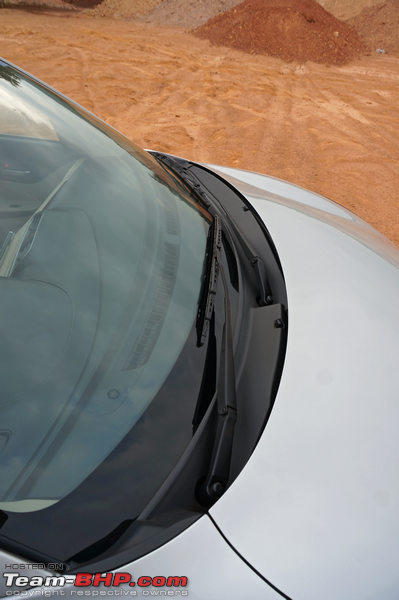 The two washers shoot out water through three nozzles each. Total of 6 jets for you: 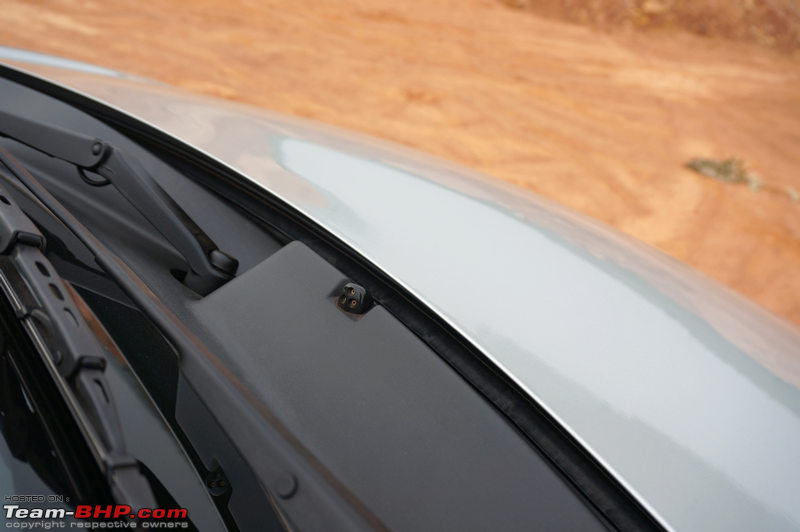 While the washer nozzles can be adjusted to alter the throw of water, I felt these wipers could have been a little bigger to cover a larger portion of the windshield: 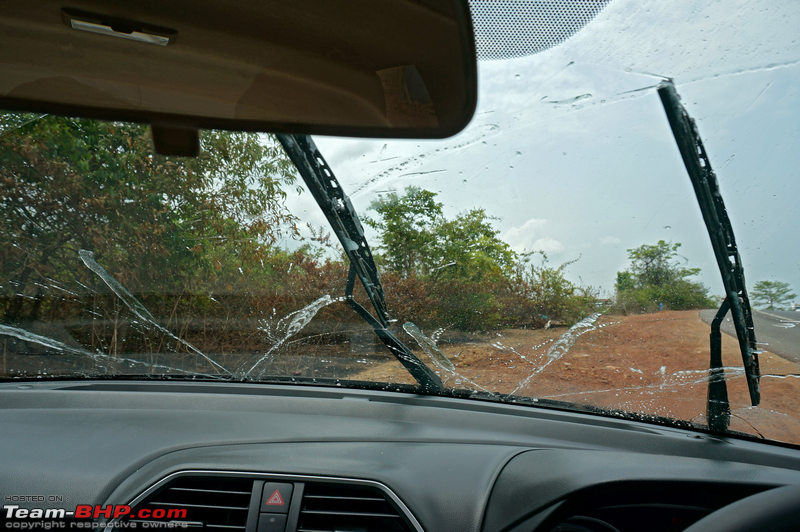 Diesel variants get DDiS badges on both front fenders. Petrol variants get VVT badges: 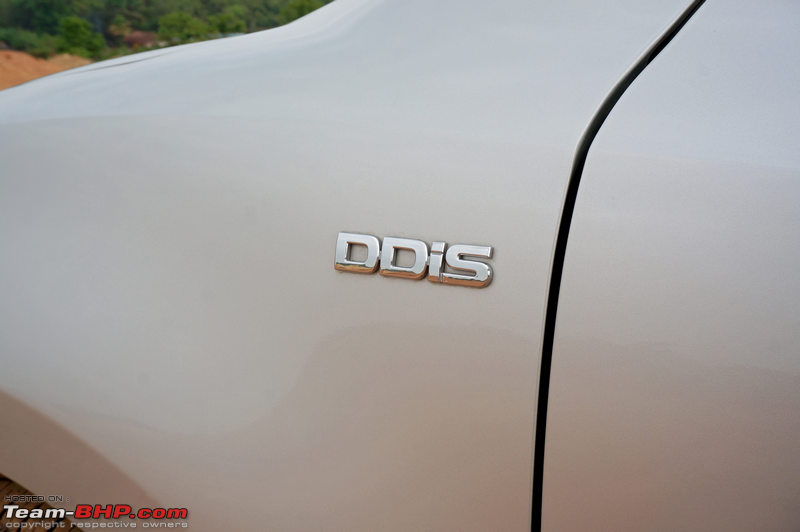 Panel gaps are consistent all over the car, but some shut lines could have been tighter: 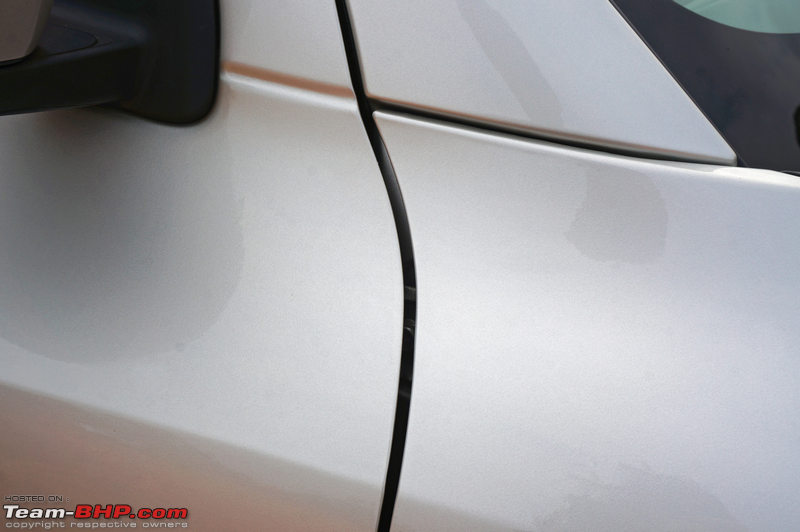 Body-coloured ORVMs are electrically-foldable and have integrated turn-indicators: 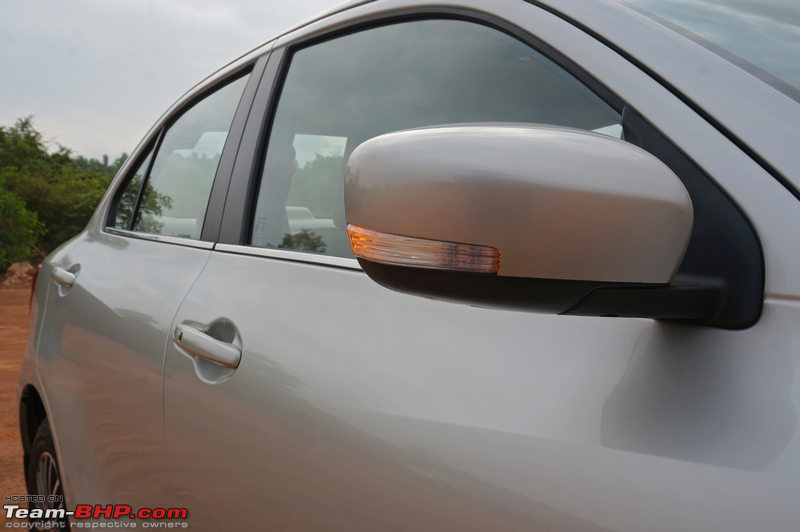 Body-coloured door handles do not feel firmly fitted and can be shaken around!! Black request sensors on both sides, but keyhole only on the driver's: 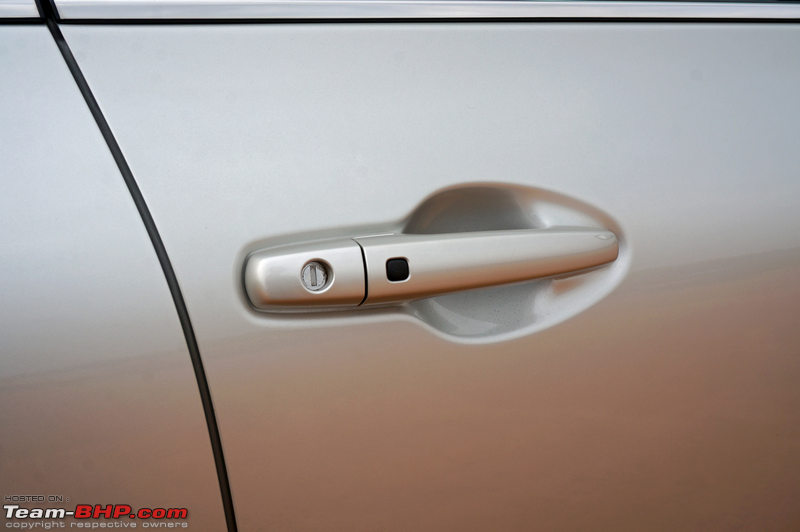 15", dual-tone, precision cut alloy wheels of the Z+ variant have 16 spokes; they look smart and successfully manage to fill the slightly beefed up wheel arches. The alloy wheels are shod with 185/65 R15 Bridgestone Ecopia tyres. Z variants get alloy wheels of a different design. L & V variants get 14" steel rims with 165/80 section tyres. Because they will be the most popular variants, you’ll see a lot of under-tyred Dzires on the road. 165 mm is such a poorly chosen tyre size: 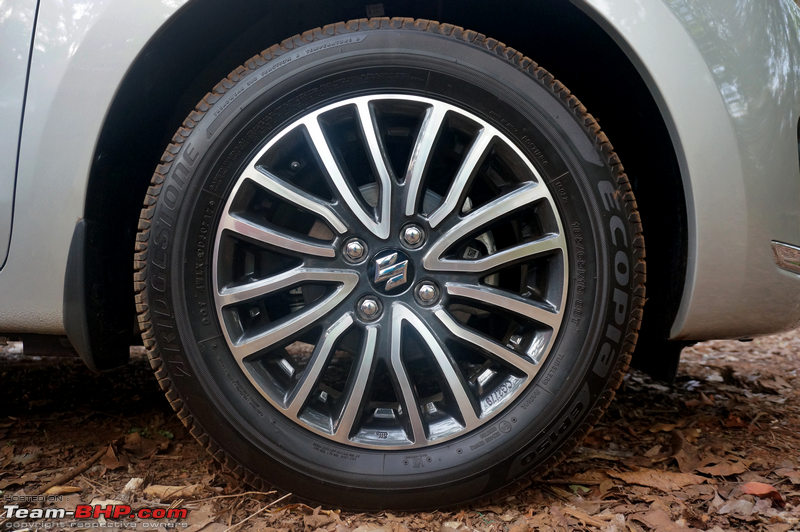 A-pillar is body-coloured and ditches the steeply inclined proportions of the earlier models. Instead, it slopes back in a gradual fashion. B-pillar is blackened and a chrome strip runs on the lower edge of the windows:  C-pillar is less steep compared to the old Dzire and helps in making the car look more sedan-like:  Like most of the car, the sides have a clean design. A rare crease you'll see: 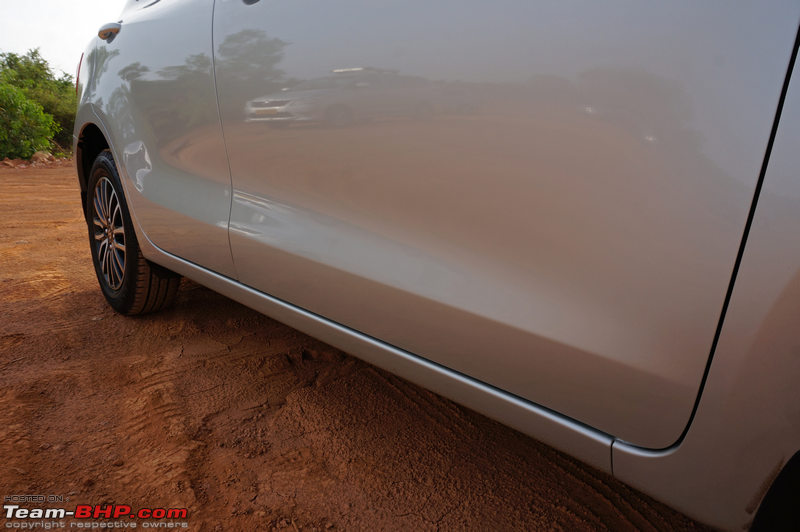 Considering the light weight nature of the car, I'd have expected a ribbed roof for additional rigidity:  Short & stubby antenna located towards the rear of the car: 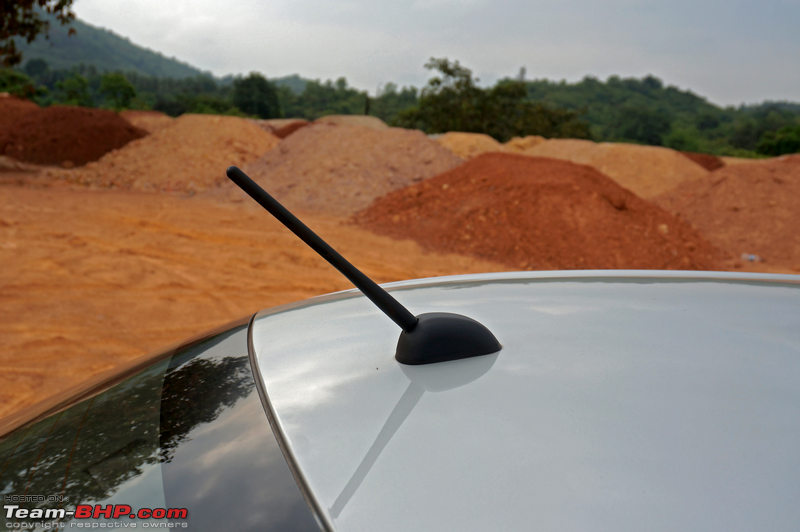 New wraparound tail-lamp clusters get LED light guides (pilot lamps) and a honeycomb pattern in the stop lamp area:  A look at the tail-lamp cluster in action. L-shaped LED light guides come on with the follow-me-home feature. Reversing lamps are provided in both tail-lamp clusters (reversing + turning lights get regular bulbs, not LEDs). Turn-indicators blink once on locking and twice on unlocking the car. No rear foglamps have been provided:  Braking lights have multiple LEDs: 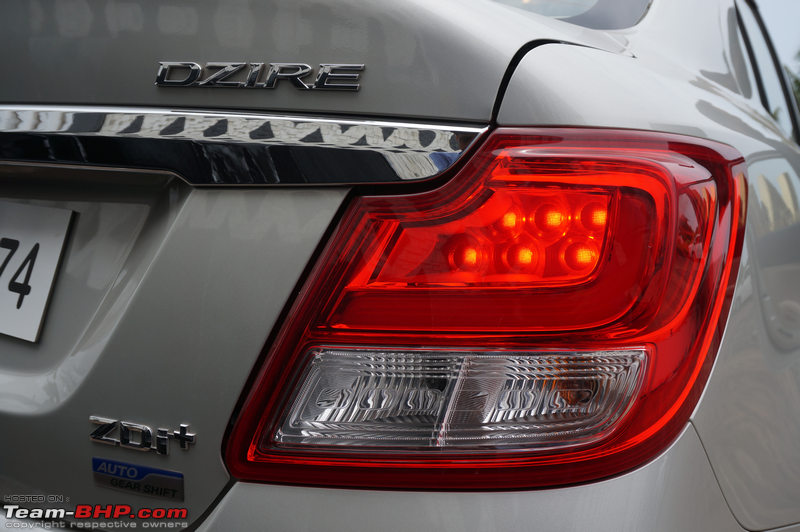 Large "S" badge sits right at the top. Thick chrome strip runs between the tail-lamps, just above the number plate housing. Notice how the tail-lamps are shaped to make the chrome strip integrate with them. The tail-lamps also stick out from the sides: 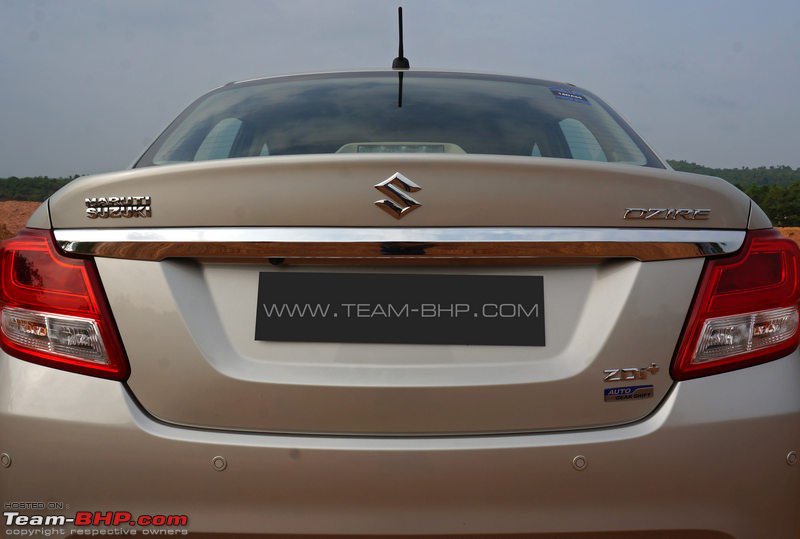 Rear bumper has a recessed area on the lower portion and houses 4 parking sensors and 2 slim reflectors. Good to see 4 parking sensors on a cheap sedan at a time when some 20 lakh cars give merely two (pic of Innova Crysta): 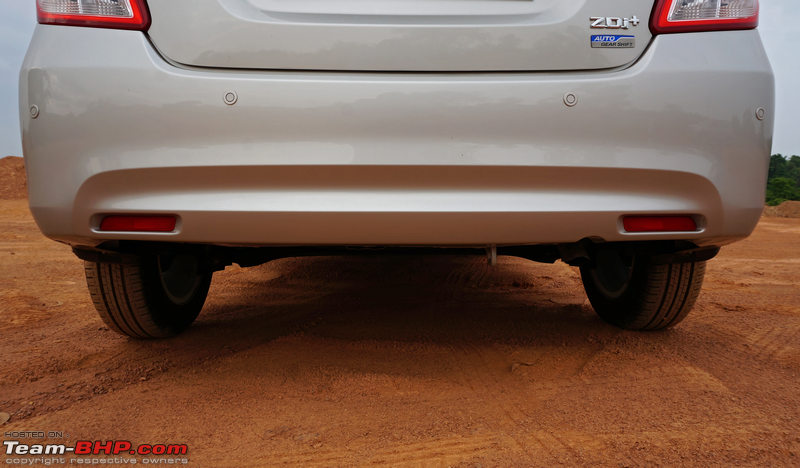 Small reversing camera is properly integrated and sits above the number plate, on the left side: 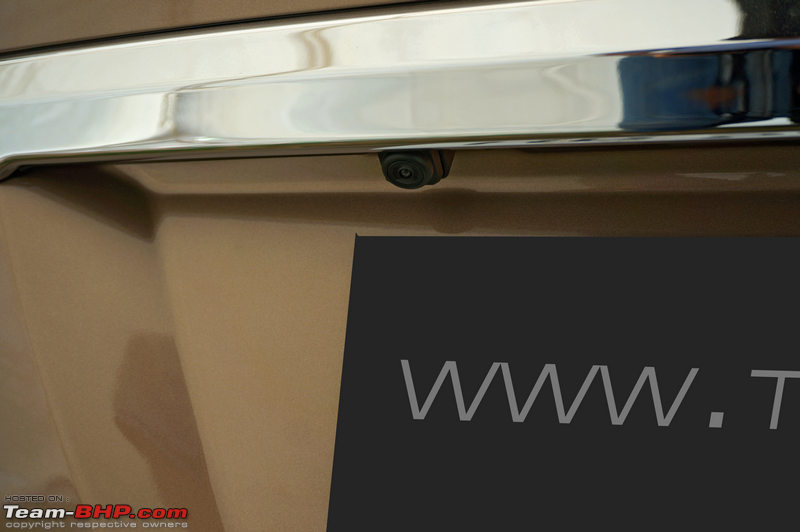 Dzire is a brand in its own right now. Drops the Swift moniker. Trim level is indicated lower on the boot lid: 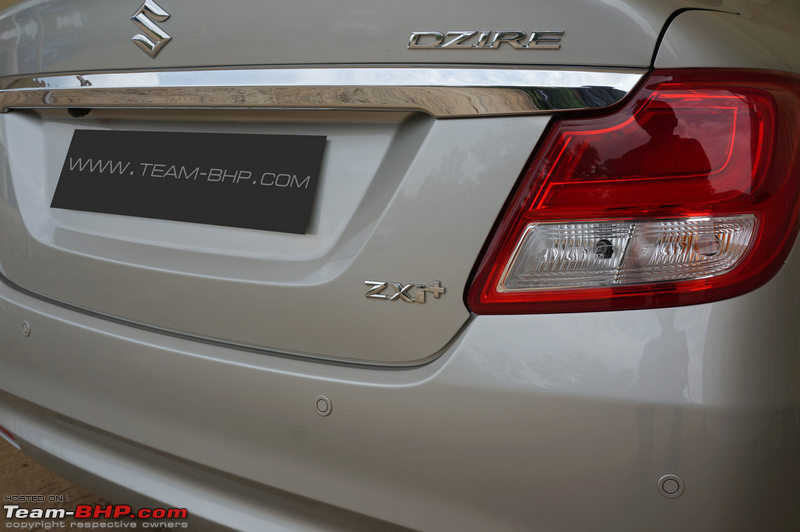 Tow-eye and tail pipe on the right. Notice the bumper cutout where the tail pipe peeps out: 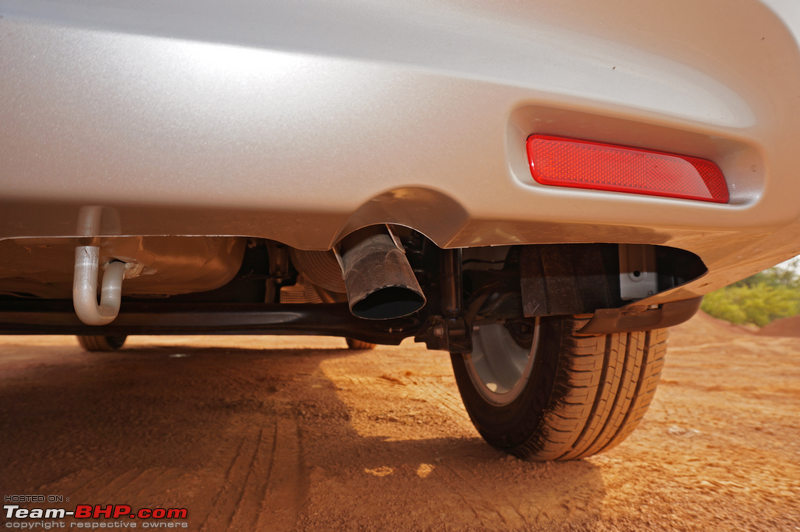 Gets a ubiquitous McPherson suspension setup at the front and...  ...a torsion beam suspension setup at the rear: 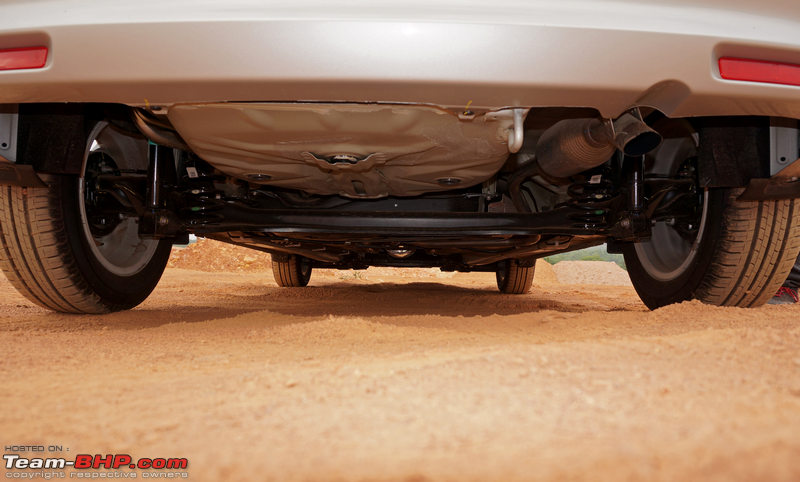 Front end looks more mature & striking now. Also seems to have gotten some Italian design flair here! 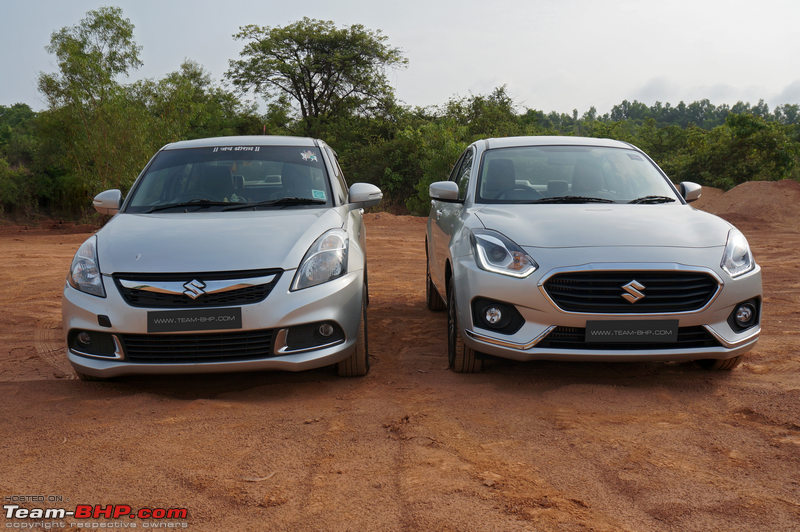 Unlike the front, the rear end does have a resemblance to the old car. That said, it is more acceptable aesthetically. The increase in width and decrease in height give the car a squatter stance: 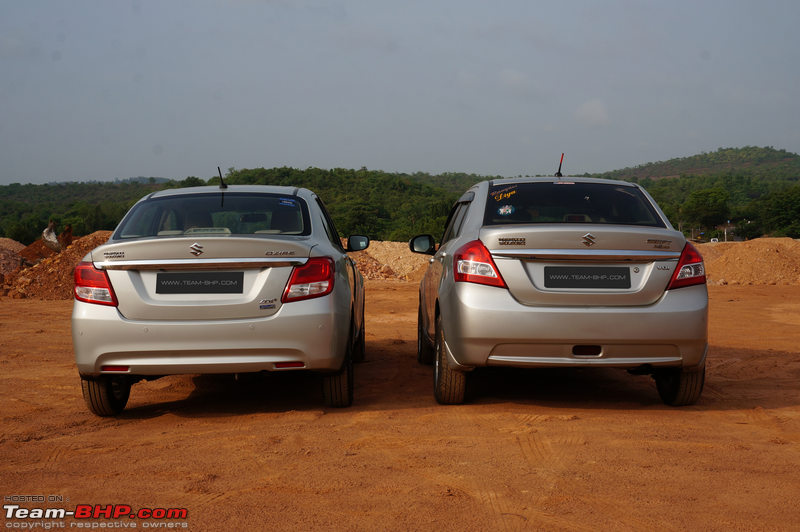 Design is a lot more graceful with a superior integration of the boot: 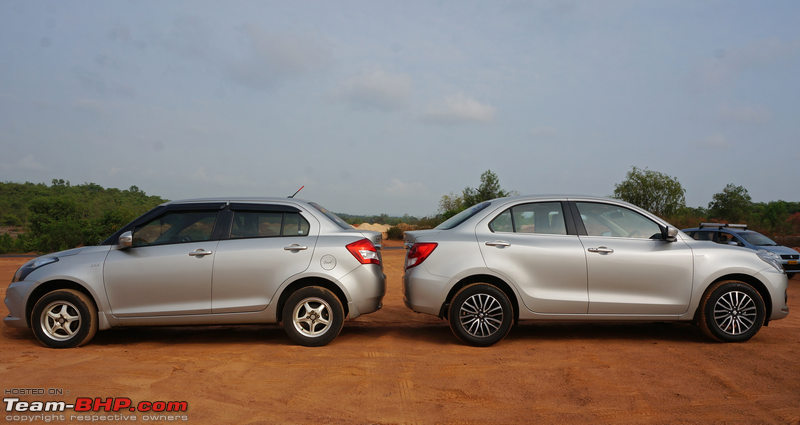 Last edited by GTO : 11th July 2017 at 09:02. |
| |  (53)
Thanks (53)
Thanks
 |
| The following 53 BHPians Thank Aditya for this useful post: | abhinav.s, aeroamit, AkMar, akshay81, anukritbhargava, AutoIndian, Avikbrio, baby_antu, blackwasp, CarguyNish, carrazy, CrAzY dRiVeR, dailydriver, darklord, deetjohn, dZired, espraveen, Gannu_1, GTO, hardyk2010, Iksvaku, iliketurtles, InControl, Jaggu, Karthik Chandra, klgiridhar, Leoshashi, libranof1987, lovetorque, Nohonking, NPV, phoenixash, Ponbaarathi, PraNeel, procrj, Rambo-RS, RavenAvi, samabhi, samaspire, SatishBisht, sdp1975, silverado, Simhi, sumitmajumdarin, The Rationalist, theexperthand, Torino, uday.ere, vaasu, vb-saan, Vik0728, vikred, y2ksrs |
| | #4 |
| Team-BHP Support  | Interior - Front 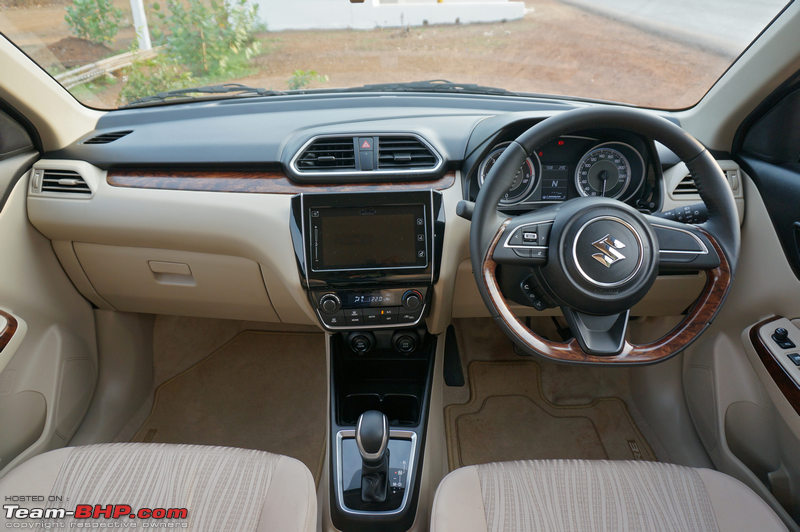 The front doors open and shut in a triple-stage action. You immediately realise how light they are - a reminder of how less the Dzire weighs. There is certainly no "European thud" when you shut the doors. The doors open wide enough and the running board is not wide either. However, while the floor of the car is not high, the roof is on the lower side too, so you have to bend a bit to get in. This is very noticeable if the driver's seat is at a lower position. Ergonomically, the cabin is well laid out and all controls are easy to find and reach. The Dzire is well-packaged in terms of cabin space. There’s good legroom & headroom. Since the car is wider than before, shoulder room at the front has increased by 20 mm. The dashboard has a neutral design like we have seen in most Maruti cars - everyone will like it. It has a beige & black theme with faux wood and silver inserts. Piano black has been used on the center fascia, around the now-familiar touchscreen infotainment system. While the beige bits brighten up the interiors, they are on the lower part of the dash and doorpads. Even the carpets and floor mats are beige!! Expect these to be soiled within a few days of ownership. They will be a royal pain to keep clean. A noticeable new addition is the fab-looking, leather-wrapped, flat-bottom steering wheel with a faux wood insert. As expected for this segment, the plastics on the dashboard are all hard. While the finish is good with no sharp edges at places that occupants are likely to touch, the overall quality of the plastics is average and not at par with the likes of say, the VW Ameo or Hyundai Xcent. That said, the quality of the cabin is a step above the outgoing car's and the materials used are acceptable. While some of the switchgear is taken from other Maruti cars, most of the buttons and switches feel good to use and appear durable. Dual-tone dashboard with the upper section finished in black, while the lower area gets beige. Faux wood and silver inserts have been added on the dashboard. Interiors are well-designed and the ergonomics are spot on with all controls falling easily to hand:  Driving position is user-friendly. Large windshield offers a clean view of the road ahead. Dash isn’t too high either – always a good thing for frontward visibility:  Sexy leather-wrapped, flat-bottom steering with thumb contours and silver, chrome & faux wood inserts. It's awesome to hold. Horn pad is not easy to reach for people with small fingers, but it is light to press: 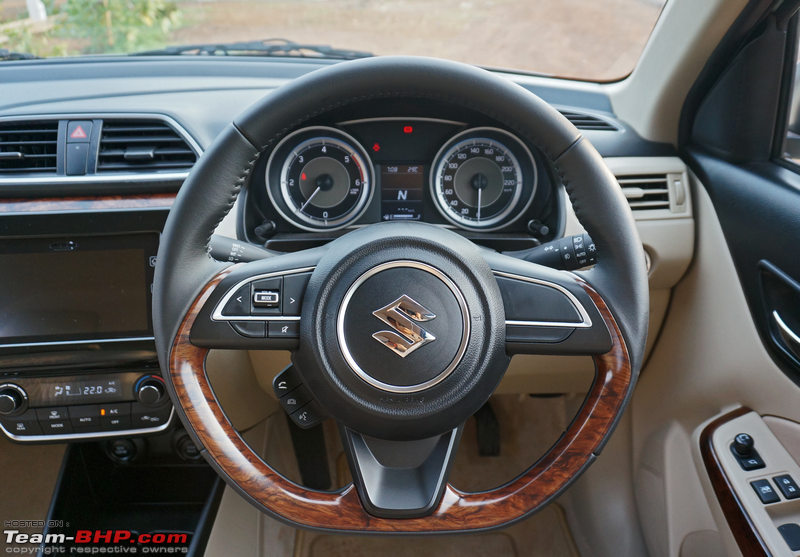 Buttons for controlling the audio system are located on the left spoke and feel premium to use. The volume and source can now be changed via a toggle switch. Mute button is useful, but does not pause the song that is being played (it kills the sound). All buttons offer satisfactory haptic feedback:  Voice control and telephony buttons are located below; should be pushed from the back to operate:  Zooming in to show you the stitching pattern of the steering. Steering thickness is just perfect:  Faux wood insert on the lower part of the steering is sure to split opinions. While most people who saw it loved it, there were some who hated it. It's not very glossy (saying this in a good way):  Steering can be adjusted for height only, not for reach even in the top spec. A big miss as the Baleno has it  : : New twin pod instrument cluster with an MID screen in the center is clear and easy to read. I like the classy silver rings (prefer it over chrome). Fonts are well-sized. The area above the MID screen houses the warning lights and indicators. No temperature gauge provided:  Ugly stalk to adjust the trip meter sticks out of the instrument cluster on the left. Should have just had a button for this:  Yet another ugly stalk on the right to adjust the brightness of the instrument cluster. Long press it to enter 'settings'. Twist it to the right or left to toggle between the functions and then, short press to select a function:  Instrument cluster is backlit in a tasteful white. Needles point down at their rest position (seen in some sports cars):  MID is black + white and relatively simple. Wish it got the sweet colour MID of the Baleno though. Still, it provides adequate information, including bars for the fuel gauge, with digital read-outs for the odometer, time, outside temperature, two trip meters, a range / DTE counter and average + instant fuel economy:  While a large portion of the manual variant's MID remains blank, the AMT version gets a large gear indicator in the middle. A host of settings can be altered using the MID. These include the shock sensors (anti-theft system), timing of the follow-me-home lights, turn-indicator flashes (lane change) and door locking system:  Illumination of the instrument cluster and MID can be adjusted in 6 steps. Brightness of other controls such as the climate control system, parking sensor button and engine start / stop button is also altered: 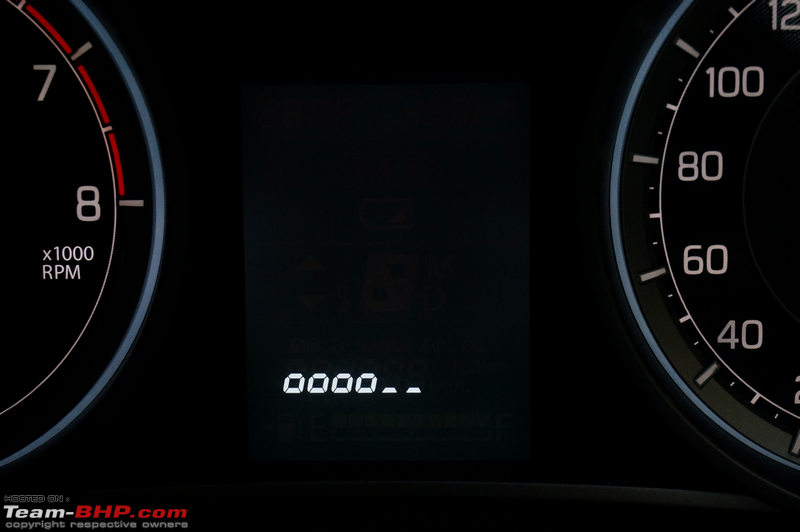 Chunky wiper and light stalks. Turn-indicators have a 'lane change' feature, which makes them flash thrice when the stalk is tapped lightly. While automatic headlamps have been provided, automatic wipers have been left out of the feature list:  Standard chrome-ringed engine start button from the Maruti parts bin is located on the right of the steering wheel:  Side air-con vents are all beige. Should have had some black / silver highlights for character; they look rather dull. Air flow volume can be adjusted or shut completely:  The 'parking sensor enable/disable' button and headlight leveller sit below the engine start button. If you disable the parking sensors, the camera still works (rightly so). Foglamp switch is located on the light stalk. Too many blanks in a car that has become more premium:  Bonnet release lever is identical to the Baleno's. It doesn't look nice, but feels sturdy:  Like the dashboard, the doorpads get a beige + black colour theme. Large beige portion is located where the occupants are likely to touch the door and store stuff. It is sure to get soiled. While the plastics are all hard, the area above the armrest and power window console is soft and gets a fabric insert. Even the armrest is padded and covered in fabric (not on the rear doors though). There is very little flex in the doorpad and there is very little movement when the windows are rolled down or up. Honda listening?  Door handles are finished in chrome and remain identical to the old car's. They don't feel robust and have a flimsy + springy action. On a related note, the door lock / unlock sound is loud. The car has auto-locking as well as auto-unlocking (when you switch the car off) doors:  Standard Maruti console that we've been seeing since ages. Maruti team obviously has some kind of emotional attachment to this piece. It's an eyesore and doesn’t feel nice to use either – very utilitarian in design & feel. Only driver's window gets one-touch up and anti-pinch functionality. Only the driver's window button is illuminated. Door mirrors are electrically foldable:  Faux wooden inserts will be a hit with the masses!  Front door armrests are padded and covered in fabric at the place where you rest your elbow:  Door pockets are not particularly wide. Can hold a 1L bottle and other small items: 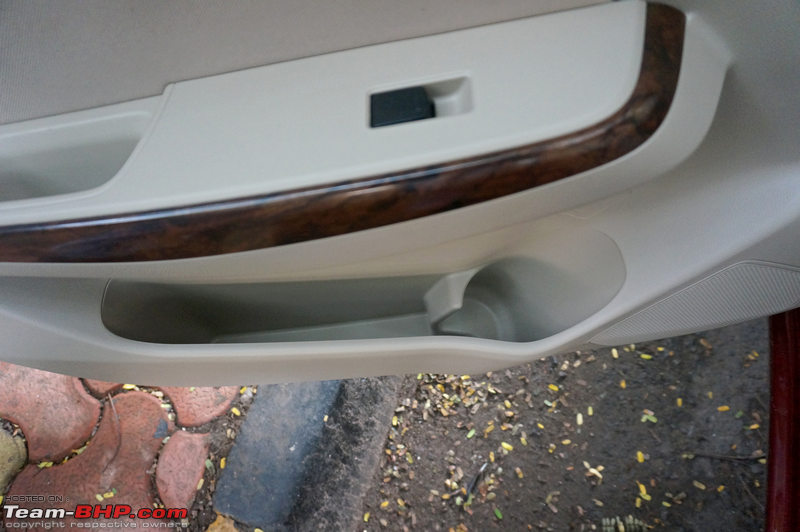 Door sills aren't too wide, which means lesser efforts are needed to move your feet in & out of the car. No scuff plates provided: 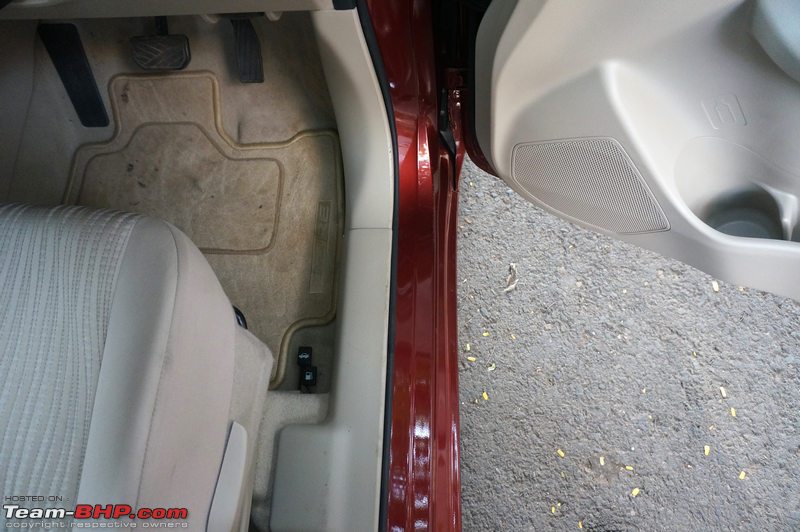 Front seats are well shaped and provide good support. Side bolstering is healthy and there is sufficient padding. Seats are slightly towards the softer side and may not be the best for long highway journeys. They are wide enough for most occupants and the cabin width ensures that the occupants do not feel too close to each other. The neck restraints are very tall (look weird) and their cushioning is on the firmer side. Quality of this fabric upholstery is satisfactory:  Driver's seat is 6-way adjustable. Lever to recline the seat feels loose, and neither lever feels very durable. Height adjustment for the driver's seat is there in the mid-variant too. Good for shorter folk: 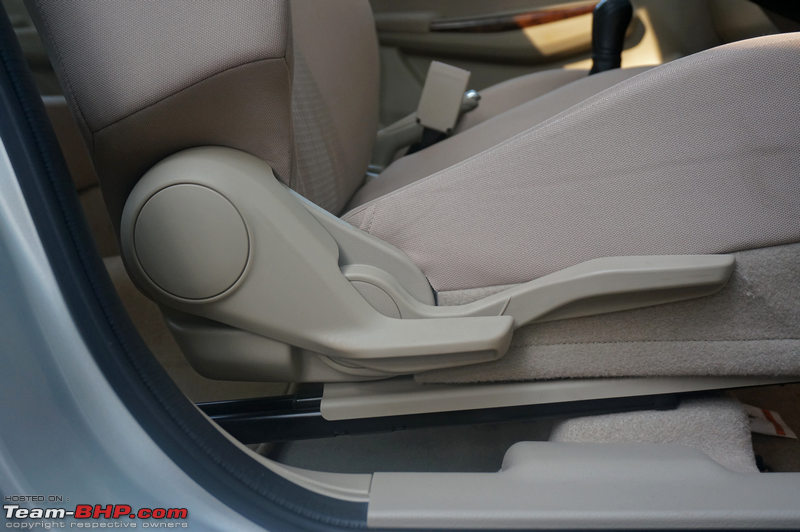 Fore & aft adjustment via this sturdy metal lever:  Fore & aft travel range is enough to allow even 6 footers to be comfortable:  Height adjustment range is healthy as well. Short or tall, no one will complain. With all the seat and steering adjustments available, it is damn easy to find the perfect driving position. You'll feel at home within minutes of being on the driver's seat:  Big headrests are nice. They look a bit weird though and are reminiscent of the ones in the jellybean Zen (from the 90s). Coupled with the B-pillar, the left headrest forms a big blind spot for the driver at intersections: 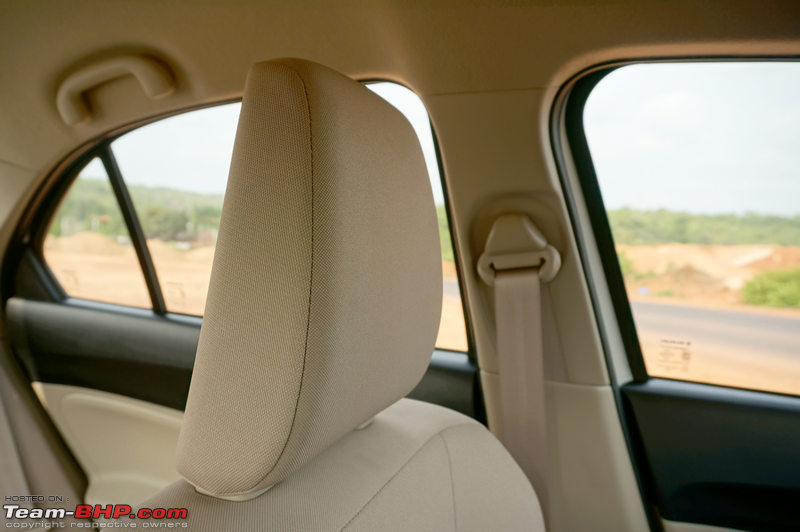 A close look at the upholstery pattern:  Seatbelts are not height-adjustable. However, they are placed at a comfortable height and will suit most occupants. They get pretensioners & force limiters:  The standard Maruti A, B, C pedals are not spaced out wide. No dead pedal provided, yet there's just enough space to rest your foot to the left of the clutch:  Boot and fuel flap release levers are located on the floor, just ahead of the driver's seat. Notice how the floor mat is designed to ensure that it doesn’t foul with them: 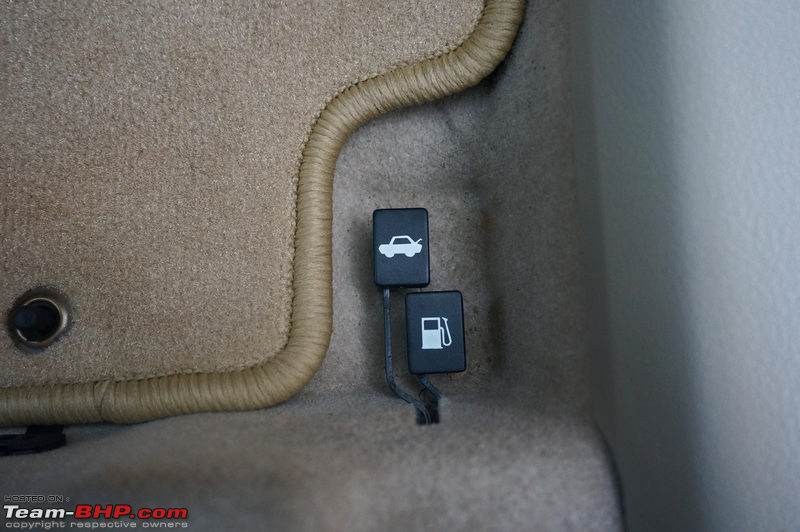 Dzire branded beige floor mats are quick to get soiled. Even the carpets are beige - what was Maruti thinking? They should’ve had black carpeting. These will be a task to keep clean:  Shape of the ORVMs is identical to other Marutis. They are sufficiently tall, although I'd have liked them to be a li'l wider: 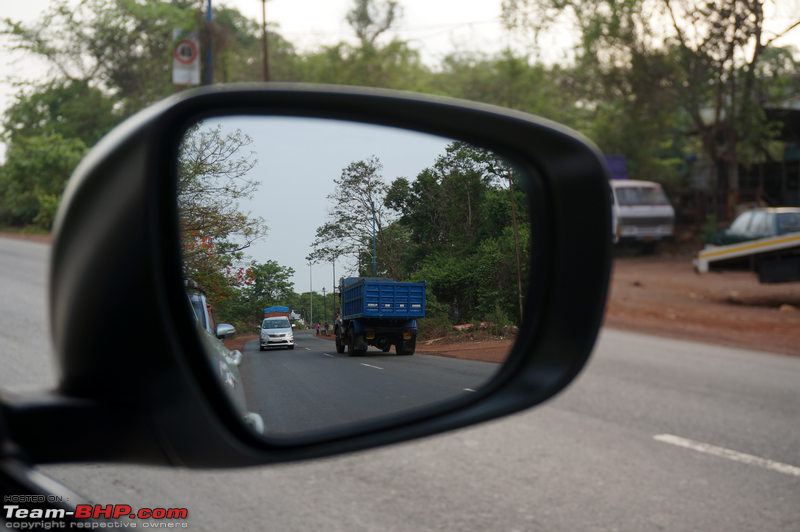 IRVM is not wide enough to cover the entire rear windshield. It doesn't get auto-dimming functionality either - a glaring omission in a car that's now so nicely kitted:  Visibility while reversing is average. While the rear headrests don't pose a problem, the thick C-pillars, tall boot, high parcel tray and tapering roofline limit the view. The reversing camera and parking sensors go a long way in making reversing easy: 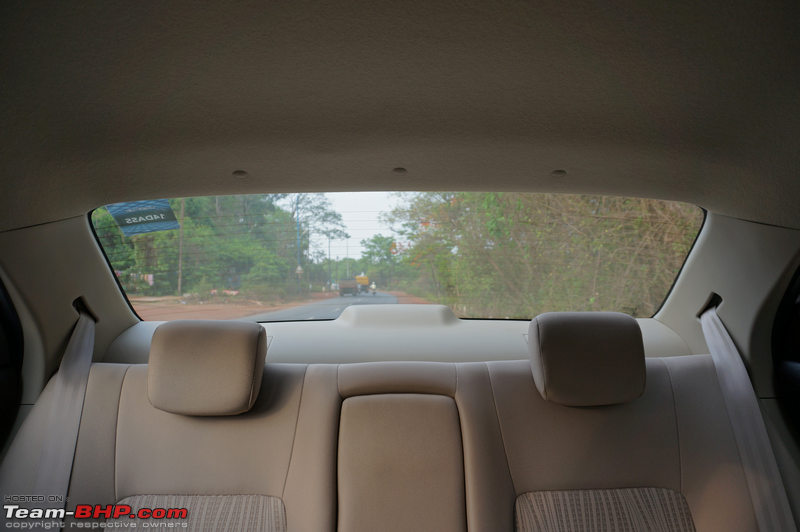 Center fascia is tilted toward the driver. Piano black has been used around the infotainment system and climate control unit:  The center air-con vents have a trapezoidal shape, instead of the circular units that have been seen on the new Swift globally. They also feature a slim silver border. No air volume controllers provided here: 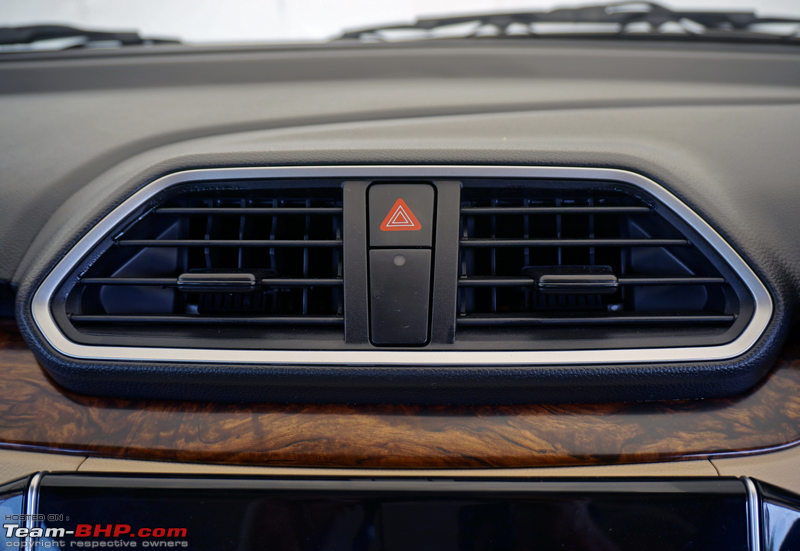 7-inch tablet-like touchscreen ICE gets piano black finishing. It has Bluetooth, USB and Aux-in connectivity, and further supports Android Auto, Apple CarPlay & MirrorLink. Very convenient. Gets an SD Card slot for navigation as well. Its functions have been covered in a dedicated post later in the review:  Touchscreen infotainment system neatly protrudes out of the center fascia and is far better integrated into the dashboard than the Ignis' unit. Sticks out only at the top:  Simple and easy-to-read climate control system gets piano black, silver and chrome touches. The blower has 8 levels of adjustment. At levels 1 and 2, it is silent. At levels 3 and 4, it gets audible. At levels 5 and 6, it is loud, while on levels 7 and 8 - the noise is excessive. The lowest temperature that the system goes to is 18 degrees centigrade before hitting 'LO', while the highest temperature level is 32 before hitting 'HI'. The cooling performance is excellent. Even in sweltering heat, the interiors were chilled quickly:  12V power outlet and USB + Aux ports are located below the climate control system on the center fascia. Both are identically styled & get flip-up plastic covers. Cool looking for sure. Storage space at the base of the center fascia can be used to place your smartphone:  Center console gets a pair of cupholders. Nope, that's not rubber lining on the base: 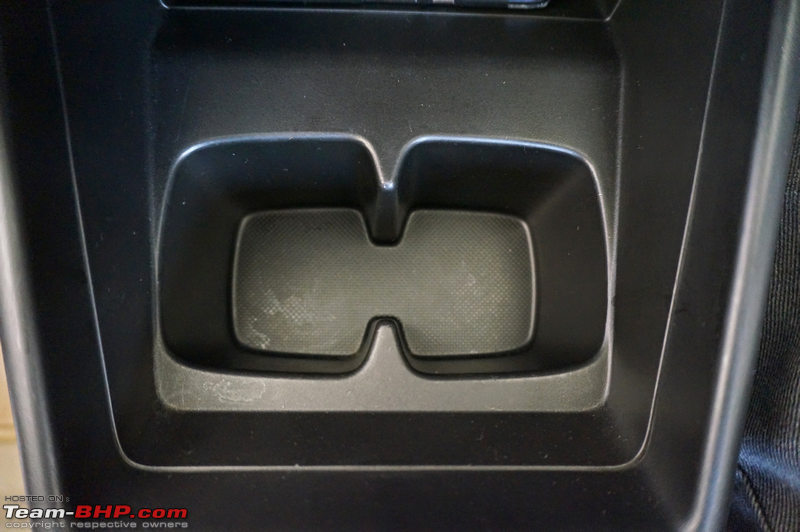 Bird's eye view of the handbrake console. No center armrest provided for the driver. This is sorely missed, particularly in the AMT variants. A wrong omission by Maruti: 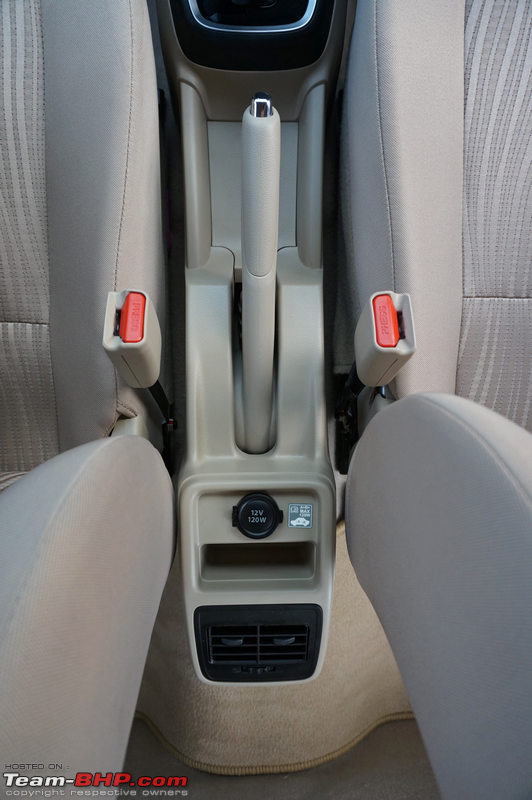 Shallow storage space below the handbrake can hold a 5.5" smartphone: 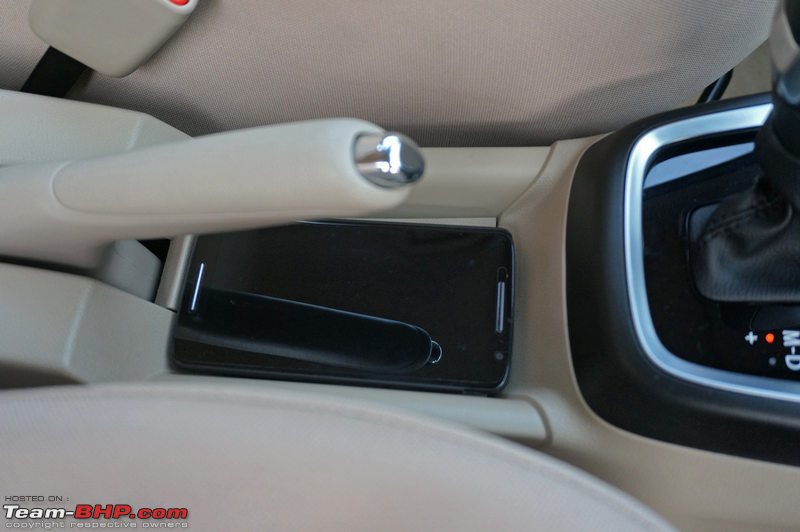 All variants of the Dzire get dual front airbags as standard. Notice how lightly the letters "SRS AIRBAG" are etched on the dashboard. Marking isn't as clear as it usually is:  Wood panelling has a matte finish and looks very tasteful. We can guarantee it’ll be a hit with the public (Bblost didn't find it appealing though). The dash is scooped in on the left side, thus freeing up more knee space for the front passenger: 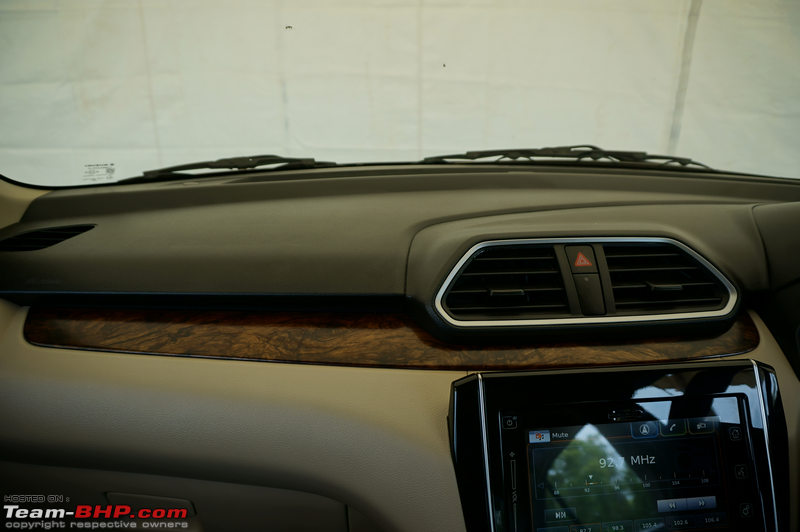 Glovebox is on the smaller side. Neither is it deep, nor does it have compartments, illumination or cooling. Additionally, the lid feels too plasticky and takes a couple of tries to close properly. The damping could be improved as well because you can hear the lid rattling as you drive along: 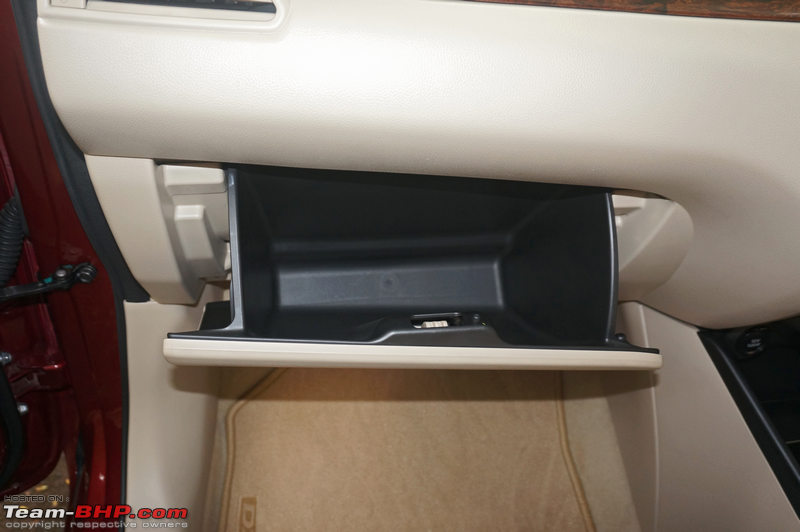 Cupholder ahead of the side vent in the ol’ Dzire (reference image) will be missed by some:  Things are generally tidy below the dashboard, with no loose wires dangling about: 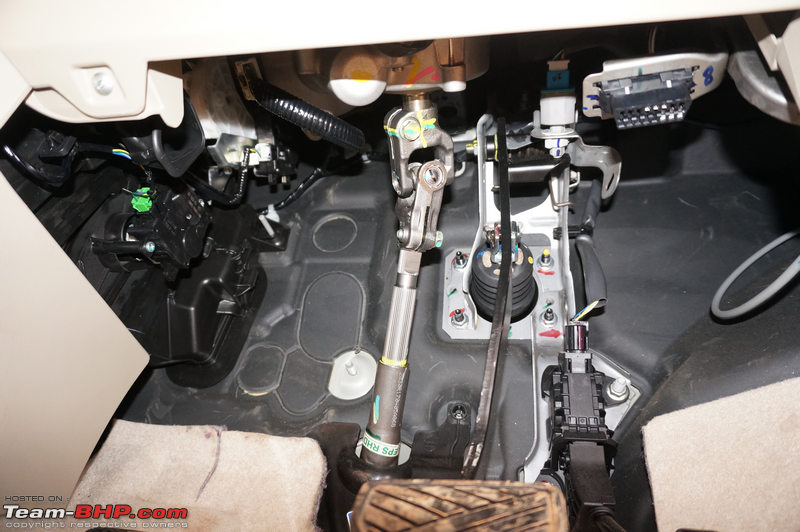 Passenger side gets a small cover as well. Gannu_1 says "it looks like a trim to cover the blower fan. Can see the directional arrow on the blower. Probably for aesthetics and to prevent the co-driver's feet from hitting the fan?" 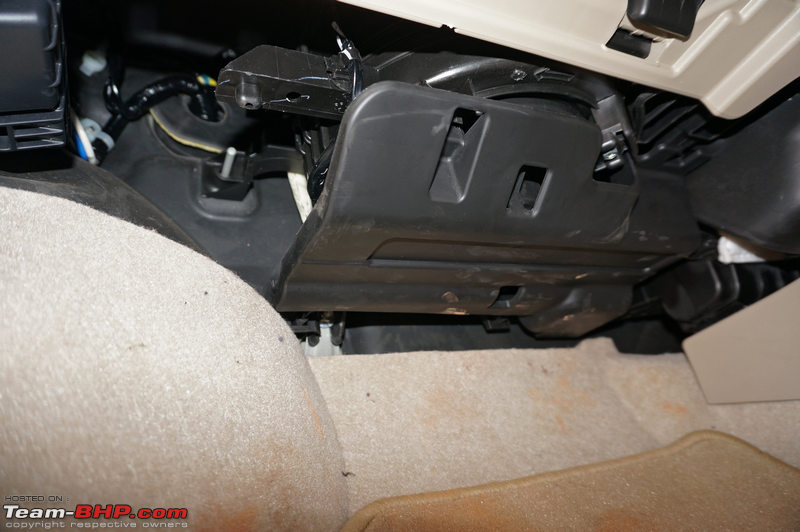 No individual map lights on the cabin lamp console. The light cluster also houses the Bluetooth mic: 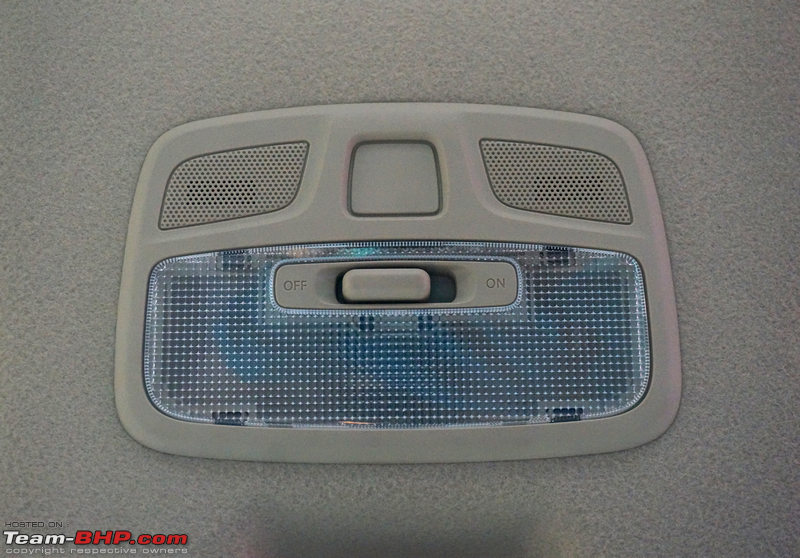 Sunvisors are economy-grade in design & feel. Driver-side unit merely gets a flap to hold tickets: 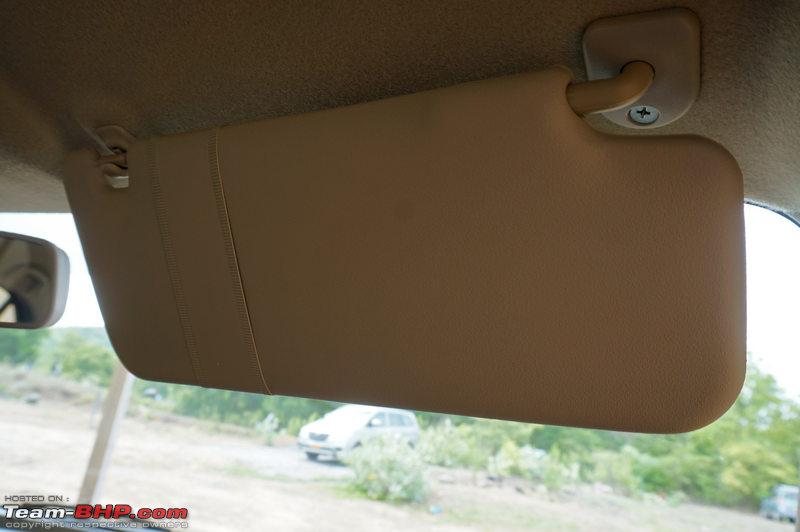 Passenger-side sunvisor gets a vanity mirror, but there's no cover or light provided: 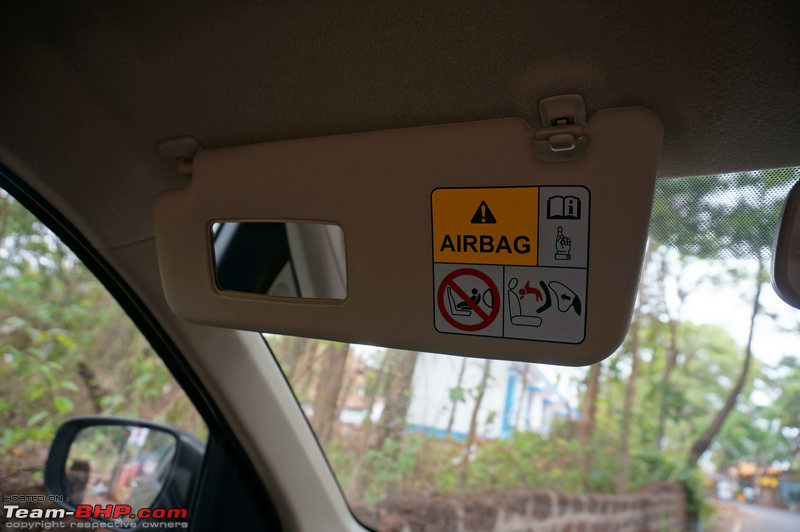 Last edited by Aditya : 11th July 2017 at 11:21. |
| |  (37)
Thanks (37)
Thanks
 |
| The following 37 BHPians Thank Aditya for this useful post: | abhinav.s, AkMar, akshay81, AutoIndian, Avikbrio, blackwasp, CarguyNish, carrazy, dailydriver, deetjohn, dkaile, dZired, Gannu_1, GTO, Iksvaku, iliketurtles, InControl, Jaggu, Karthik Chandra, libranof1987, lovetorque, Nohonking, NPV, phoenixash, Ponbaarathi, PraNeel, Rambo-RS, RavenAvi, samabhi, SatishBisht, silverado, Simhi, The Rationalist, theexperthand, Torino, vaasu, vb-saan |
| | #5 |
| Team-BHP Support  | Interior - Rear Like the front, the rear doors of the Dzire open and close in a triple-stage action (unique as most cars have a dual-stage action at the rear). We felt they didn't open sufficiently wide and the roof of the car is low. The rear seat is also placed lower than we would like, which means you have to 'sit down' in the car. This makes ingress & egress a bit inconvenient for taller people, although average-sized users should not have a problem:  Wide gap between the B-pillar and the bench makes it easier to step in & out:  Door sill isn't excessively wide either, which means occupants do not have to carry their feet over the sill when entering or exiting the car. The absence of scuff plates is more apparent in cars with lighter body colours: 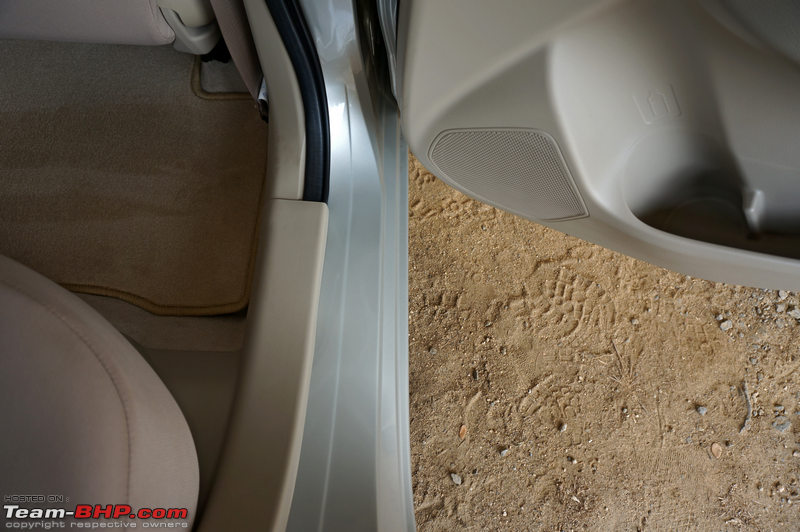 Like the front, the rear doorpads get a beige and black colour theme. The faux wood, padding and fabric inserts are only at the front though:  The doorpad can hold a 1L bottle, and the door pocket is wider than the one in the front. At the same time, it isn't as long and its carrying capacity is limited to small items:  Rear bench is nicely shaped with a contoured seatbase. Though designed to carry 3 passengers, only 2 headrests have been provided:  Just like at the front, the rear seat is wider than the outgoing car's. Still, its not a sedan in which you can have 3 healthy adults on the back seat. The seatbase is raised in the middle where the third passenger sits. This means he has lesser headroom than the side occupants:  Middle passenger gets a lap belt. Seatbelt buckles are housed in dedicated cutouts in the rear seat. They can be pushed completely in:  With the increase in wheelbase length, Maruti claims to have added 55 mm of legroom at the rear:  A look at the maximum and minimum legroom:  Good legroom. With the front seat in my driving position (5'10"), I have about 3 inches of knee room to spare. With the front seat in the full forward position, the knee room is around 10 inches. If the front seats are moved all the way back, my knees touch the seatback. However, it is soft and scooped out, so it does not hurt. Additionally, there is adequate space below the front seats which enables you to slide your feet under them:  The seatbacks are scooped out, which helps in freeing up some more knee room for the rear seat occupants:  Rear bench has sufficient cushioning, but is set low. This means that you sit down in it. At 5'10", I found the under-thigh support to be strictly average - medium-sized folk will be fine, but taller occupants will find it missing. Headroom was sufficient for me, but again, 6 footers will find it tight. The seatback angle is nice and relaxed, although the cushioning is rather soft. This means lesser support on longer journeys. The headrests are adjustable, but have only two positions - all the way up or all the way down (nothing in between):  Large front headrests severely obstruct the frontal visibility of rear passengers. They look so weird too!  The rear center armrest is wide, soft & comfortable to use. It comes with two useable cupholders:  ISOFIX child seat anchors have been provided on both sides. This is a standard feature in all variants of the Dzire  : : Parcel shelf is useless if you want to keep anything on it. It slopes down towards the front and there is no lip. IMHO, this is a good thing as we're not fans of placing stuff here (blocks the driver's view & moves under hard driving):  Anchor points on both sides of the parcel shelf for the child seats:  Overall glass area is adequate. There's enough light coming in at the back and the beige interiors ensure that passengers don't feel claustrophobic:  Rear window can be rolled down all the way:  Only front passenger seat has a seatback pocket. It is not deep, yet adequately wide:  Spring-loaded grab handles above each passenger door have a damped action. No coat hooks provided:  Rear passengers get air-con vents with individual horizontal direction control. Vertical direction control and the air volume regulator are common. The air flow cannot be completely shut off. While the plastic used feels cheap, the rear air-con works well. It does make a difference. That said, the vents might break with use (especially if you have playful kids):  Narrow storage space above the rear air-con console is perfect to park your phone (5.5 inch smartphone shown here):  12V power socket right next to it allows you to charge your phone: 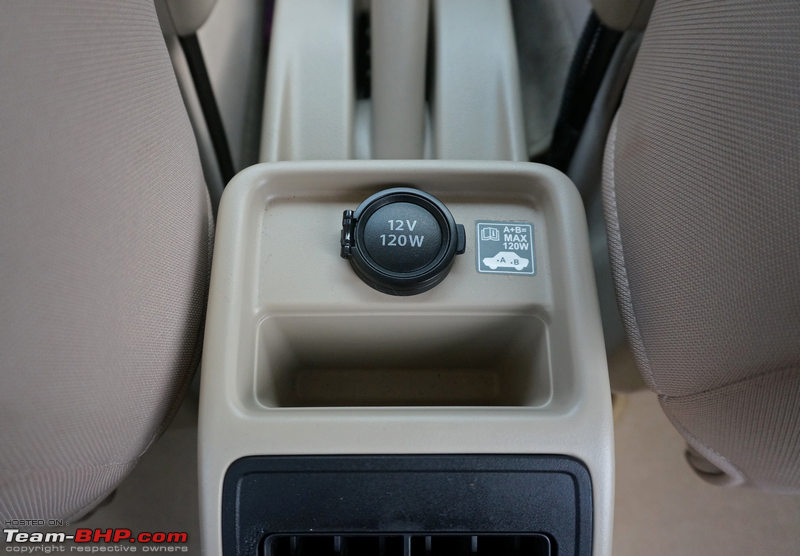 In dZired's preview of the new Dzire, he had mentioned how the rear air-con vent panel was ill-fitting (reference image). While this car had it better, the panel still does not fit perfectly:  Floor hump is about 3 inches high and not very wide. Still, this coupled with the rear air-con means the middle passenger will prefer to put his feet on either side of the hump: 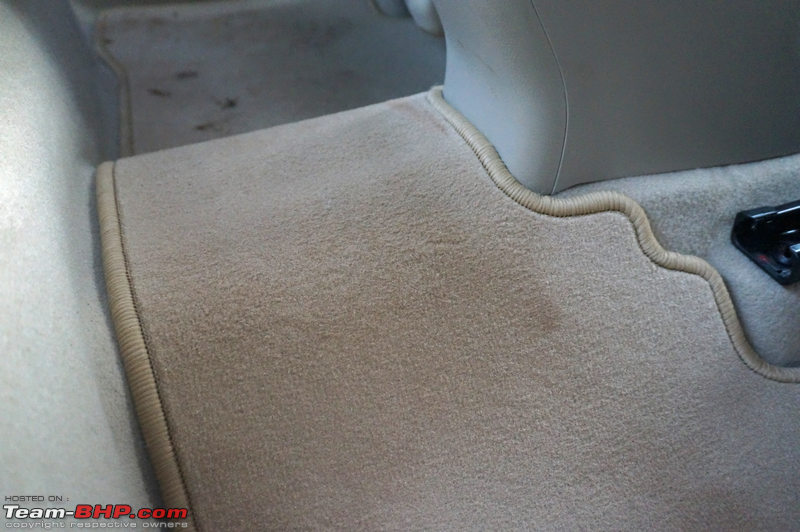 Useful cabin light placed between the front & rear seats. Strange how some manufacturers miss out on this. All cabin lights go out with a theatre dimming effect when the car is locked:  Boot lid is wafer thin and very light to lift. Like a tin can! The boot can be opened via all the usual ways (electromagnetic button, keyfob, boot release lever below the driver's seat):  Boot space has gone up from 316L to 378L. In effect, the Dzire's cabin space as well as boot capacity have gone up, even though the overall vehicle length is identical to the outgoing car. Packaging brilliance! The boot is finally useable and no longer a deal breaker. It features a full carpet and looks well finished. However, the opening is not as wide (on the lower side) as the Tigor's and the loading lip is high as well: 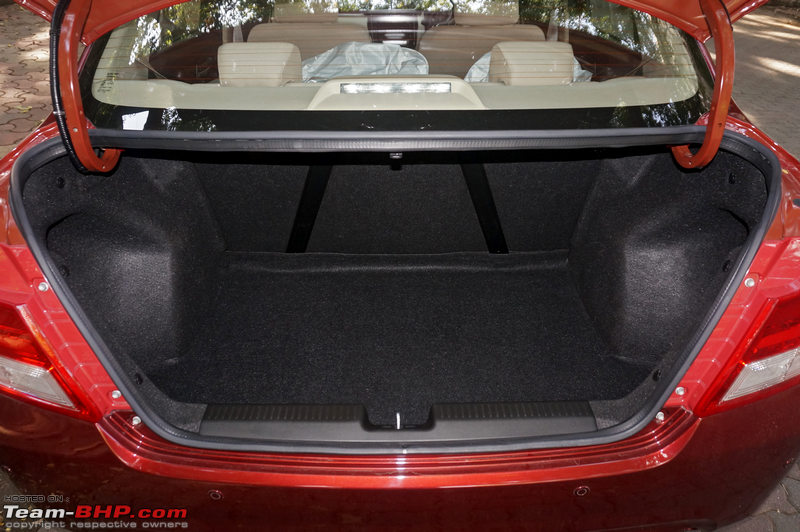 While luggage space has increased, the boot is still not as large as the Tigor (419L), Xcent (407L), Amaze (400L) & Zest (390L). The rear seat does not fold down:  Boot lid is naked on the underside with large gaping holes - looks awful. This is a common sight in most cars of the segment. However, it must be remembered that the cheaper Tata Tigor comes with a full cladding here (reference image):  The boot gets a lamp, though the underside doesn't look pleasant at all. There is no proper paint coating and bolts jutting out from the top may damage soft bags. The exposed bolts and mechanism are such an eyesore:  Thin cord to lift the boot floor up:  Nifty hook provided to hold the boot floor up, should you need to access the spare tyre:  Spare wheel is a 14-inch steel unit with a 165/80 section tyre and a speed limit of 80 km/h. Maruti should've given a full-size spare to the top variant. Since the spare is the same size as the standard wheels of the lower variants, this speed limit doesn't apply to the L & V trims:  No Styrofoam casing or a dedicated slot to tuck away the toolkit. Kit consists of the regular tyre-changing tools and a safety triangle. Notice the cloth bag for storing them: 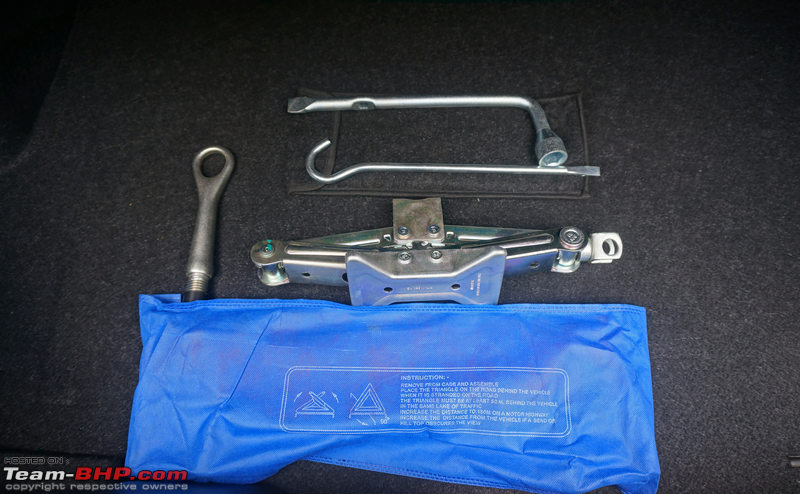 Last edited by Aditya : 11th July 2017 at 07:47. |
| |  (31)
Thanks (31)
Thanks
 |
| The following 31 BHPians Thank Aditya for this useful post: | abhinav.s, arvind71181, AutoIndian, Avikbrio, blackwasp, CarguyNish, carrazy, deetjohn, espraveen, Gannu_1, GTO, hardyk2010, Iksvaku, InControl, Jaggu, Karthik Chandra, libranof1987, lovetorque, Nohonking, NPV, phoenixash, Rambo-RS, RavenAvi, SatishBisht, silverado, Simhi, The Rationalist, theexperthand, Torino, uday.ere, vb-saan |
| | #6 |
| Team-BHP Support  | In-Car Entertainment The Z+ (top) variants of the Maruti Dzire get a SmartPlay touchscreen infotainment system, which offers smartphone connectivity with Android Auto, Apple CarPlay and Mirror Link. Music is played through 6 speakers (including 2 tweeters). Connectivity is through Bluetooth, USB and Aux. A CD player is missing, but then, who uses CDs today. The system also comes with navigation and voice recognition & serves as a screen for the reversing camera. The now familiar 7-inch touchscreen is very easy to operate, but visibility under direct sunlight is average. While the screen is pretty sensitive to scrolling and clicking, there is a little lag. It is not as quick as scrolling on a smartphone. The home screen is divided into four logical sections. Piano black panels look sweet:  In the Z & Z+ variants, music is played out through 6 speakers (including 2 front tweeters). V variants get 4 speakers: 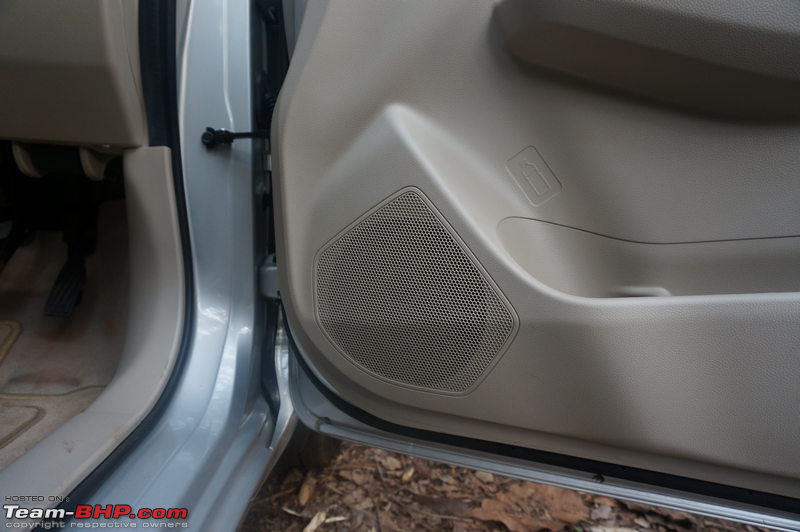 Tweeters placed on the doors create a pretty high sound stage. Feels like the music is coming from the ear level:  Rear speakers are placed on the doors and not on the parcel shelf:  Music can be played from a variety of sources (including SD Card):  The interface is simple and easy to operate. Font size is large as well, making it easy to read on the go:  Sound settings include the usual equaliser settings and fader / balance adjustments. For a car of this segment, the sound quality is satisfactory, especially at low to medium listening volumes. It is only at higher volumes that you notice a distortion in the bass. We also felt the treble was on the higher side. Even at level 3, it sounded excessive. You might want to turn it down by a level or two in the equaliser settings:  A number of presets are also provided:  Navigation is via pre-loaded maps on an SD card:  You have to 'confirm' each time before using the navigation system. This can get rather irritating. Looks like the lawyers won over the usability experts at Maruti:  Maps provided by Nokia HERE. Interface is standard fare: 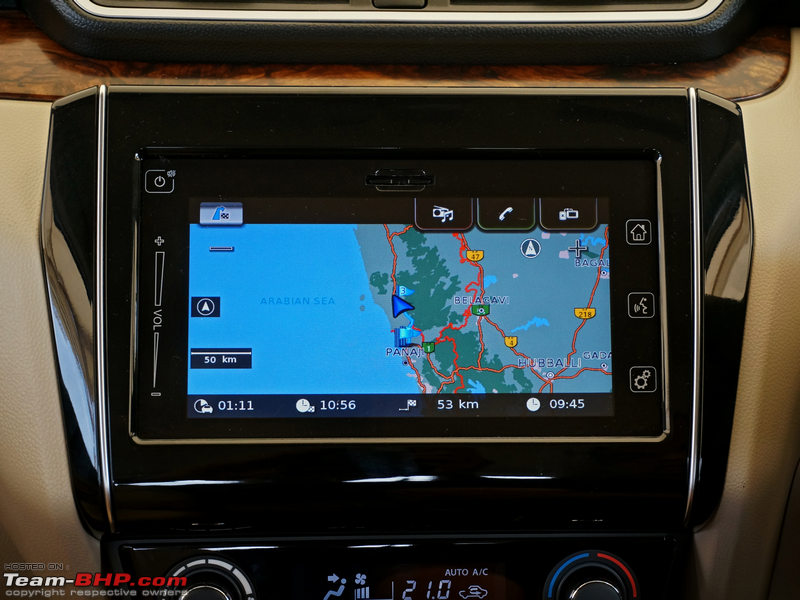 You can enter your destination through the touchscreen or by giving voice commands:  Pairing with your smartphone is quick & easy. Owners will love the iOS & Android integration:  Phone clarity is satisfactory:  Dzire is the second car from Maruti to get Android Auto, Ignis being the first. To use it, owners have to connect their smartphones to the system via a USB cable:  Users can get directions, make calls, send and receive messages and listen to music + audio books through a touch interface:  Navigation through Google Maps is very easy. Android Auto also helps in getting real time traffic updates (via Google) on the screen:  Owners of the Z+ variant can download the Suzuki SLDA Remote App on their smartphones, connect it to the infotainment system via Bluetooth and use their phones just like a remote control. Might be useful for chauffeured owners:  You can switch the audio system on or off with the app. You can also select the music source, adjust the volume to your liking and mute/unmute the system:  Parking display is clear with colour-coded distance demarcations. However, it does not get adaptive guidelines. That said, the camera along with the reverse parking sensors help greatly while backing up:  One can alter the brightness & contrast levels of the display:  Last edited by Aditya : 11th July 2017 at 07:48. |
| |  (27)
Thanks (27)
Thanks
 |
| The following 27 BHPians Thank Aditya for this useful post: | abhinav.s, akshay81, arvind71181, Avikbrio, CarguyNish, dailydriver, espraveen, Gannu_1, GTO, Iksvaku, Jaggu, Karthik Chandra, Leoshashi, libranof1987, lovetorque, NPV, phoenixash, Ponbaarathi, Rambo-RS, RavenAvi, silverado, Simhi, theexperthand, uday.ere, vaasu, vb-saan, virtualdanger |
| | #7 |
| Team-BHP Support  | Driving the 1.2L Petrol MT Familiar 1.2L K12 engine found in many other Maruti cars. Even with a small engine bay, empty spaces are visible. Notice that the petrol doesn't get an engine cover:  The Dzire petrol is powered by the same 1,197cc, 4-cylinder K12 petrol engine with variable valve timing technology (VVT) that powered the outgoing car. This engine is also found in other Maruti products such as the Swift, Baleno and Ignis. Like the Ignis, this mill produces 82 BHP @ 6,000 rpm and 113 Nm of torque @ 4,200 rpm, which is 1 BHP lesser than the Baleno and 2 BHP lesser than the Swift and old Dzire. The torque produced is also lesser by 2 Nm and produced at 200 rpm higher. With a kerb weight of merely 860-895 kilos, the Dzire is the lightest car in its class. It has a power-to-weight ratio of 95 BHP / ton and torque-to-weight ratio of 131 Nm / ton. Both these figures overshadow most of the other C1 segment cars such as the Honda Amaze and the Hyundai Xcent. In fact, it's only the Ford Aspire with its 1.5L petrol engine that betters the Dzire. Due to the low weight, the power to weight and torque to weight ratios of the new Dzire are 7 BHP / ton and 8 Nm / ton higher than the old car's and just 1 BHP / ton and 2 Nm / ton short of the Baleno's. To start the engine, you to need to press the clutch and then hit the engine start / stop button. Once fired up, there are no noticeable vibrations on either the steering, pedals or the gear lever. In general, the refinement of the engine at idle is very good. The 1.2L K-series has been around since seven years now, but it’s still a jewel of a motor and feels ‘more with the times’ than the 1.3L diesel. With the lighter weight of the new Dzire, the engine feels more sprightly and the throttle response is very crisp. The Dzire moves off from a standstill easily and offers good driveability in the city. The engine's low rpm behaviour will satisfy most drivers and you can potter around town in 4th gear at 40 km/h with the engine ticking over at 1,250 rpm without feeling lugged. There is adequate power on offer & you won't be downshifting too often either. Keeping up with city traffic is no trouble for the 1.2L petrol. This low-speed behaviour coupled with the compact size, light controls, good frontal visibility and sorted ergonomics makes the Dzire a very good car for driving in the city. Take the Dzire out on the open roads and one can really enjoy the performance that the 1.2L unit offers. Power delivery is linear in nature and the rev-happy engine is refined throughout the rpm range. While there is enough power available over 1,000 rpm, the engine really starts feeling very responsive above 2,500 rpm and accelerates strongly all the way to the redline. Along with the spirited performance, the 1.2L engine sounds sweet, and enthusiasts will enjoy high-revving it. The strong engine makes the Dzire a competent performer on the highway. The only downside is that Maruti has set the max engine rpm to a rather conservative 6,300 rpm. You get the feeling that the engine has a few hundred rpms left in reserve when you (unexpectedly) hit the rev limiter in the middle of an overtaking maneuver. This will force you to upshift, losing time in the process. The Dzire can cruise on the highway at 100 km/h with the engine turning over at 2,500 rpm. While there is sufficient power throughout the rev range, it’s best to shift down a gear or two while overtaking on single lane highways to keep the Dzire in the meat of its power band. The clutch is very light and pressing it takes close to no effort. It's travel range is neither too long nor too short. The 5-speed manual gearbox is smooth to operate with short throws. It’s precise, so you will never miss a gear or slot into the wrong one. The gearshift quality along with the rev happy nature of the petrol engine makes this combination a great choice for driving. With its light kerb weight, the Dzire petrol has a claimed fuel consumption figure of 22.0 km/l, which makes it the most fuel-efficient petrol car in the segment. The old Dzire, which had a rating of 19.1 km/l, has been left in the dust. Coming to NVH levels, the Dzire does very well at slow speeds and around town. The engine is barely audible at city speeds. But when you climb up the revs, you realise Maruti has skimped on the insulation materials. At high rpms, the engine is more audible than you would expect. While this might appeal to enthusiasts, regular folk are not likely to be impressed. At speeds above 100 km/h, road and wind noise start creeping into the cabin too. These get louder as the speed increases. There are some vibrations felt on the steering wheel as well as the gear lever at higher rpms. Free-revving petrol engine produces 82 BHP and 113 Nm of torque:  Both - the petrol and diesel - get an insulation sheet under the bonnet:  The firewall insulation. While it is sufficient in the petrol, it isn't enough for the diesel:  No underbody protection. You can see the ground below clearly:  VVT badge on the front fenders denotes the petrol engine under the hood:  Driving the 1.2L Petrol AMT Apart from the 5-speed manual transmission, the 1.2L petrol engine is available with a 5-speed automated manual transmission, which Maruti calls 'Auto Gear Shift' (AGS). The 5-speed AMT unit is sourced from Magneti Marelli and is being offered on the VXi, ZXi and ZXi+ variants. While this is not the first time Maruti has used this engine - transmission combination, it is the first time it is employed in the Dzire. The old car came with a 4-speed torque converter unit. The AMT mechanism is a simple bolt-on job and it uses the Dzire MT's existing gearbox. It's pretty straightforward in the way it works. Mechanically, the AMT gearbox is identical to the Dzire’ manual transmission. What's different is how the clutch is operated and how the gears are shifted. In the manual, the driver is responsible for these tasks. With the AMT, hydraulic actuators located in the engine bay operate the clutch and shift gears. There's no clutch pedal, and zero driver input is required for gearshifts, making it exactly like a conventional automatic to drive. Simply put, the mechanical functions of operating the clutch and gear lever have moved from inside the cabin to the engine bay. To know more about AMTs & how they work, click here. AMTs, as we know, are cheaper to build than proper automatic gearboxes (torque converters, dual clutches). However, Maruti has priced the Dzire petrol AMT at Rs. 6.73 lakhs (VXi), Rs. 7.49 lakhs (ZXi) and Rs. 8.37 lakhs (ZXi+), which is at par with other automatic cars in the segment. In fact, the Ford Aspire with the 1.5L engine and dual-clutch automatic transmission is priced at Rs. 8.16 lakhs (Rs. 21,000 lower than the Dzire ZXi+ AMT)! Compared to the MT, the Dzire AMT carries a premium of ~ Rs. 47,000 across all trim levels. The AMT has the standard N, R, D and M positions. There is no 'P' (park) mode or gear unlock button like in a conventional AT. To start the car, the gear shifter has to be in N (neutral) position and the driver's foot has to be on the brake pedal. The Dzire AMT has no problem rolling off from a standstill. Throttle response when starting off is very good. The AMT functions like a regular automatic gearbox and, as the driver doesn't need to press a clutch pedal or shift gears, it results in a stress-free drive. Additionally, putting the car in D / M mode and releasing the brake pedal will result in the Dzire creeping forward without any accelerator input. In bumper to bumper traffic, you can drive the Dzire with only one pedal (i.e. the brake). Without any throttle input, the car will keep moving at ~7 km/h. In general, keeping up with urban traffic is easy. However, the gearbox suffers from slow gearshifts (particularly during upshifting) and there is a delay of a second or so from the time one gear is disengaged and the next one is engaged. This results in a jerk and as we've noticed in other AMTs - the lull in acceleration makes your head bob forward. If the car is being driven in a relaxed manner, things are smoother (although you will still notice each gearshift). The gearbox's operation is silent too. It's only when the driver gets aggressive with the throttle that things get jerkier, resulting in your head swaying back & forth. That said, Maruti is definitely improving the smoothness of the shifts of the AMT with each new car launch; however, there is no comparison with a conventional AT in terms of smoothness. It is important to note that while every upshift from 1st to 3rd gears is felt, the shifting between 4th and 5th is smoother. There is a way of reducing these jerks. When accelerating up to speed, let off the accelerator at specific intervals. The AMT will seize that opportunity to upshift. With a light foot, higher gears are engaged at ~ 2,000 rpm. Overall, the larger K12 engine is a better combination with the AMT vs the AMT + K10 in the Celerio and Alto. The larger motor masks the shortfalls of the AMT to a fair extent. The AMT and K10 engine combination is jerkier and because the smaller engine is down on power, the gearbox has more work to do. On the open road, the AMT is much more at ease with a relaxed driving style than an aggressive one. It works well for a driver who prefers to build up speed gradually. The engine has enough grunt to keep the Dzire running at triple digit speeds all day long and with a light foot, the transmission is also smoother. Driving in D mode is good on the highway as long as you are happy to cruise. Speaking of which, she cruises at 100 km/h in 5th gear at 2,750 rpm. Put your foot hard down and the engine revs to 5,800 rpm before the transmission shifts up. What is noticeable is the way the revs jump up when the driver slams the throttle to match the revs in the lower gear while the transmission eagerly shifts down. The shift, however, is nowhere close to being as quick as a DSG. That said, the response time is not as slow as some other cars with AMTs. It is quite acceptable for expressway driving. Even then, it's best to use the manual mode while overtaking on undivided highways. The AMT comes equipped with 'Manual mode' that can be engaged by moving the gear shifter to D, and then to the left. Pull the shifter down to upshift and push it up to downshift. In M mode, the transmission does not upshift on its own. Driven hard, the engine will rev to 6,250 rpm. It will not allow you to upshift if it finds the revs too low or downshift if the resultant revvs are too high. M mode comes in handy when one wants to overtake quickly. While the response time is far from instant, it's still a bit faster than D mode. M mode is useful to bring the engine into its powerband before an overtaking maneuver & also during the actual overtaking (to prevent the AMT from an unintentional + slow upshift while you're overtaking). Another time when the M mode can be used is when you desire engine braking. Driving downhill, this mode aids engine braking which in turn, reduces the workload on the brakes. It must be mentioned that there is a slight delay between the time you tap the gear lever and the gearshift actually happening, resulting in a jerk. Therefore, even in this mode, it is advisable to let go off the throttle for an instant while upshifting, just like you would do in the case of a conventional manual transmission. NVH levels are identical to those of the MT. Coming to fuel consumption, the AMT's claimed FE figure is identical to the manual's 22.0 km/l. Magneti Marelli-sourced AMT unit sits on top of the gearbox:  AMT shifter is similar to the old Dzire automatic's, the only differences being the colour and the missing O/D button. It looks good, but shift actions can get jerky. Might be a deal breaker for some:  The gear console is finished in piano black and has a sweet silver border. Like other AMT’s, there’s no "P" mode:  AMT's MID gets a gear indicator. The car cannot be started unless neutral (N) has been engaged. The "D" next to the "1" denotes "automatic" mode, while the "M" denotes "manual" mode. Currently selected gear is shown in both, automatic & manual modes. The transmission allows you to shift up to 2nd gear even when the car is standing still. The car can move from a standstill in 2nd:  Last edited by GTO : 11th July 2017 at 09:13. |
| |  (25)
Thanks (25)
Thanks
 |
| The following 25 BHPians Thank Aditya for this useful post: | abhinav.s, AkMar, AutoIndian, Avikbrio, blackwasp, CarguyNish, dailydriver, deetjohn, espraveen, Gannu_1, GTO, heavenlybull, Jaggu, Karthik Chandra, Leoshashi, libranof1987, lovetorque, NPV, phoenixash, PraNeel, RavenAvi, theexperthand, Torino, uday.ere, vb-saan |
| | #8 |
| Team-BHP Support  | Driving the 1.3L Diesel MT Fiat-sourced 1.3L DDiS engine needs no introduction, shared with many other cars from Maruti and other manufacturers. This engine fills up the engine bay more than the petrol. It’s also beginning to show it’s age now compared to it’s more modern competition:  The Dzire diesel is powered by the same 1,248cc, 4-cylinder diesel engine found in many cars from the Fiat, GM, Maruti and Tata stables. Maruti calls this unit the DDiS 190. It features a fixed geometry turbocharger with an intercooler and common rail direct injection technology. It develops 74 BHP @ 4,000 rpm and peak torque of 190 Nm @ 2,000 rpm, which is identical to its siblings. Once again, it's the new Dzire's lower kerb weight of 955-990 kilos that gives it better power to weight (77 BHP / ton) and torque to weight (199 Nm / ton) ratios than its predecessor (71 BHP & 182 Nm). The Dzire diesel has an average power to weight ratio in the C1 segment. Cars like the Ford Aspire, Honda Amaze and VW Ameo manage to easily better its figures since they have more powerful 1.5L engines. Where the Dzire petrol was impressive, the Dzire diesel is 'adequate'. Like the petrol Dzire, you have to depress the clutch and hit the engine start button to fire up the engine. On startup, there is a slight shake and mild vibrations are felt on the gear lever and pedals. The familiar clatter of the diesel is very clearly audible inside. Off the line, the car moves off without any effort. There is a little turbo lag, but even at low rpms, it’s not dead. In fact, you can even get moving from a standstill in second gear without stalling. Maruti has done a good job of tuning the engine for the city. In most conditions, there is enough torque available and you don't need to downshift too often. Things change when you need to close gaps quickly. Put your foot down and the lag is felt. In such situations, you definitely need to downshift. Here, it simply doesn’t have the low speed torque of the Aspire or Amaze. The Dzire's engine starts coming into its stride from 1,500 rpm and you feel the turbo kicking in after you cross 2,000 rpm. On the open road, the Dzire diesel is no slouch, but neither can we say it is exciting. You won’t really like to rev the engine hard till the redline. All the action is concentrated in the mid-range between 2,000 - 4,000 rpm. Beyond 4,000 rpm, the power starts tapering off and at high revs, the engine makes you feel aware that it’s strained. Additionally, beyond 3,000 rpm, the noise from the diesel engine starts getting loud which can be tiring on longer journeys. The car is at its best if you build speed gradually and cruise on the highway. Chill & enjoy the tall fuel economy figures, we say! In 5th gear, when doing 100 km/h, the engine is ticking over at 2,200 rpm. On the expressway, you will not find the need to downshift while overtaking. It’s only when you are on an undivided highway and the speed and rpms drop considerably, that you will find the need to downshift. In general, you always get the feeling that the 1.3L oil-burner has adequate power and torque to keep the average Joe happy, yet enthusiastic drivers are likely to look elsewhere (read = Aspire & Ameo). The clutch is light with an average travel range and isn't likely to tire anyone. Like all other cars that use this engine, the Dzire Diesel MT gets a 5-speed manual gearbox. This unit is light to operate, with short throws and well-defined gates. Coming to NVH levels, the diesel clatter and engine noise filtering into the cabin are certainly more than what you'd expect in a modern sedan. Besides, the 1.3L powerplant is now feeling old. As I have mentioned earlier, above 3,000 rpm, the engine noise is loud and beyond 4,000 rpm, it starts sounding and feeling rough. When driving at higher rpms, you will notice some vibrations on the steering wheel, pedals and a buzz on the gear lever. Vibrations are also felt inside the cabin when you turn off the engine. Like the petrol, wind and road noise start creeping into the cabin beyond 100 km/h. That said, the overall insulation is slightly better than the outgoing car's. Due to the lesser weight of the 2017 car, the engine does not have to work as hard as earlier, which means it has a higher fuel efficiency rating. The Dzire diesel can return 28.40 km/l, which makes it the most efficient car in the country! This is a good thing, because Maruti has given the Dzire a tiny 37L fuel tank - 5L smaller than the old car. Diesel engine gets an engine cover, unlike the petrol. It features a fixed geometry turbocharger and develops 74 BHP and 190 Nm of torque:  Intercooler is located at the front, towards the right side of the engine bay:  No underbody protection for the diesel either:  There is a visible gap in the engine bay where the wheel arches are located. Bblost put his fingers through this gap to demonstrate:  VIN is etched on the right side of the engine bay:  5-speed manual gear lever has a leather boot and a chrome insert. The console has a silver border just like the AMT's. It is shared with the petrol and other vehicles from the Maruti stable. The shift action is light and smooth:  Gearshift indicator in the manual suggests when to shift up or down. Newbies will appreciate this:  Driving the 1.3L Diesel AMT Like the petrol, the diesel variant of the Dzire is also available with a Magneti Marelli-sourced 5-speed automated manual transmission (AMT). This engine - transmission combination has been carried over from the outgoing model and the Ignis. AMT unit is placed at the same location as the petrol variant:  The AMT transmission is available on the VDi, ZDi and ZDi+ variants in the Dzire diesel. Priced at Rs. 7.75 lakhs, Rs. 8.51 lakhs and Rs. 9.39 lakhs for the VDi, ZDi and ZDI+ variants respectively, the Dzire diesel AMT also commands a premium of ~ Rs. 47,000 over the MT. It must be recollected that the Tata Zest with the same engine and the same gearbox is priced lower than the Dzire diesel AMT, while the better built and faster VW Ameo TDi with the smooth and quick DSG gearbox is priced at Rs. 9.90 lakhs. The working and behaviour of the AMT is absolutely identical to the one in the Dzire petrol, as explained in the earlier post. Starting the car requires you to put it in N, pressing the brake and hitting the starter button. On startup, there is a slight vibration felt on the gear shifter as well as some cabin shake. Moving off from a standstill is not a problem for the diesel AMT. However, it is not quite as instant as the petrol. The throttle response is duller as well. As we have seen earlier, the AMT functions just like a regular automatic gearbox, and the driver doesn't need to press a clutch pedal or shift gears manually. Again, engaging D / M mode and releasing the brake pedal will see the car creep forward without use of the accelerator - very useful in stop & go traffic. Without any throttle input, the Dzire diesel AMT will keep crawling at ~8 km/h. The creep function works in reverse gear as well. In urban conditions, keeping up with traffic will not be an issue. However, even with a light foot, the gearbox does not shift up from 1st to 2nd gear before the revs cross 2,000 rpm. As the throttle response is dull, you will feel the need to press the accelerator more than in the petrol to get the car moving. As the engine has some turbo lag & there's no torque-converter AT to mask it, all the power feels like it is delivered in a lump. When the traffic in front slows down and you have to release the accelerator, the revs drop quickly and the jerk felt is very annoying. This makes the experience even more unpleasant as you have to deal with the AMT jerks during shifts as well as when you release the throttle. The AMT also has some weirdness. Say, you take your foot off the accelerator just as the turbo has spooled, the car will still accelerate for a second (thanks to the turbo's boost). This takes some getting used to. There is no such issue with the petrol AMT. It is best to drive the car in a sedate manner as aggressive driving only makes matters worse. The back and forth motion caused by the jerkiness of the AMT along with the dull throttle response and turbo lag could prove to be quite a deal-breaker for the Dzire. Just like the petrol, the jerks can be reduced by lifting off the accelerator at intervals and allowing it to shift up smoothly. The petrol AMT seems to be the better option if you’re going for the AMT as it’s smoother than the diesel. On the highway as well, the AMT is more comfortable with a driver building up speed in a moderate manner. This will enable the car to cruise comfortably with the occupants getting a smoother experience. The car can cruise at 100 km/h all day long with the engine ticking over at a relaxed 2,300 rpm. Like the petrol, on flooring the accelerator, the transmission readily shifts down with the engine blipping the throttle to match the revs. The AMT's downshift response time has improved and is comparable to a conventional AT in many situations. Maruti has clearly worked on it. In fact, the shift times are identical to the petrol version. Keep the accelerator pinned down and the engine revs to 4,000 rpm before the transmission shifts up. M ('Manual mode') can be engaged by moving the gear shifter to D, and then to the left. Pull the shifter down to upshift and push it up to downshift. On hard acceleration, the engine revvs to the redline and the transmission doesn't shift up. M mode comes in handy when one wants to execute quick overtaking maneuvers on undivided highways. It can be also used during downhill driving, when you can make use of the engine braking (although it's lesser in the diesel than the petrol). Additionally, even while driving uphill, there are times when you get the feeling that the engine holds its revs a bit too long in D. The noise from the diesel engine gets loud and annoying. In such times, I found myself using the M mode to upshift and quieten things down. In higher gears, the transmission allows you to upshift at ~ 1,750 rpm. Just like in the petrol version, it is advisable to lift off the throttle momentarily while upshifting to get a smoother and quicker shift. NVH levels and fuel consumption are identical to the manual variant. On pressing the brake (clutch in the case of the manual), a green light appears on the instrument cluster, after which the start/stop button needs to be pressed to start the car:  No clutch pedal means more space in the footwell. The automatic has a fairly wide and usable dead pedal. I found its angle to be quite comfortable to rest my foot on:  AMT variants get an 'Auto Gear Shift' badge on their boot lids:  Last edited by GTO : 16th July 2017 at 11:45. |
| |  (27)
Thanks (27)
Thanks
 |
| The following 27 BHPians Thank Aditya for this useful post: | abhinav.s, arvind71181, AutoIndian, Avikbrio, blackwasp, CarguyNish, deetjohn, dZired, espraveen, Gannu_1, GTO, HighwayHopper, Jaggu, Karthik Chandra, Leoshashi, libranof1987, lovetorque, Nohonking, NPV, phoenixash, RavenAvi, silverado, Simhi, theexperthand, uday.ere, vaasu, vb-saan |
| | #9 |
| Team-BHP Support  | Ride & Handling The Dzire comes with a ubiquitous McPherson strut suspension setup at the front and a torsion beam setup at the rear. The overall urban ride quality is compliant. At lower speeds, a li'l firmness is felt due to the 15" wheels (not the case with 14" variants), yet it's never uncomfortable. Small bumps on the road are absorbed quite well. There is no choppiness or bumpiness either. Even at the rear, bumps are not jarring for occupants. What is impressive is the way Maruti has managed to make the suspension function silently. On the open road, most bumps and undulations won't bother you. However, large and sharp bumps make themselves felt. Go fast over these and the ride can suffer. Nope, this isn't a car that will 'flatten' bad roads. The high speed stability of the Dzire is satisfactory, despite the light kerb weight. It can cruise at 100 km/h all day long without feeling nervous. Of course, it does not have that rock solid feel of the Europeans, but it is by no means unstable. It feels well planted and even slightly rough patches of road do not seem to affect its composure. In terms of handling, grip levels are good and the car can change direction very easily. Body roll is controlled and the overall road manners are pretty good. The Dzire behaves as intended by family sedan standards - no nasty surprises here (trust me, we cornered!). Do note that our comments are based on the higher variant's 185 mm tyres, and not the woefully under-tyred 165 mm variants. Even with the higher variants, the 185/65 R15 Bridgestone Ecopia tyres are designed more towards mileage than grip. Enthusiasts may want to upgrade to grippier rubber. The electric power steering is one-finger light at parking and city speeds. This makes it a very easy car to drive in urban situations, but enthusiasts are likely to find it too dull as it is light and feedback is lesser than we'd like. It must be noted that the diesel's steering feels firmer than that of the petrol. At higher speeds, the steering does weigh up alright. The Dzire has a tight turning radius of 4.8 meters, which makes U-turns a breeze to execute. Together with the light steering, AMT gearbox and excellent ergonomics, this makes the Dzire very easy to pilot in urban conditions. However, one must remember that the steering's return-to-center action is very weak (a design flaw). This means that the driver will have to actually turn the wheel back straight after a U-turn!! The Dzire's unladen ground clearance is rated at 163 mm. That's low compared to other cars in the segment. In fact, it is the lowest in its class! While we didn't scrape over any bumps, we didn't load the car up with 4 passengers & luggage either. Team-BHP ownership reports will tell the real-world story. Like the old car, the new Dzire comes with disc brakes at the front and drum brakes at the rear. However, in the new car, the braking performance is noticeably better. On hard braking, the car stops in a straight line, sans any drama. The brake pedal has a short travel range and the brakes start biting early on. On applying more pressure, they do a competent job of stopping the car. ABS + EBD is standard on all variants of the Dzire. It is not intrusive and kicks in only on hard braking in emergency situations. Last edited by Aditya : 11th July 2017 at 07:53. |
| |  (30)
Thanks (30)
Thanks
 |
| The following 30 BHPians Thank Aditya for this useful post: | abhinav.s, AkMar, Avikbrio, blackwasp, CarguyNish, deetjohn, dZired, espraveen, Gannu_1, GTO, HighwayHopper, Jaggu, Karthik Chandra, Leoshashi, libranof1987, lovetorque, Nohonking, NPV, phoenixash, PraNeel, PuntoMania, Rambo-RS, RavenAvi, silverado, sups, theexperthand, thegodfr, uday.ere, vaasu, vb-saan |
| | #10 |
| Team-BHP Support  | Other Points • First spotted testing by Team-BHP fan Harpal Singh in October 2016. First images without camouflage appeared online in March 2017, while those of the interiors surfaced in April 2017. • Team-BHP brought you scoop info regarding Maruti's plans for the old & new Dzire in January 2017. • Unveiled in April 2017. Thanks to BHPian dZired for giving us a wonderful preview. Thanks to BHPian RavenAvi for sharing the product brochure prior to the car's launch. • The Dzire has improved in nearly every way, except for the diesel engine. The 1.3L MJD is nowhere as impressive as the Ford & VW 1.5L motors. Maruti desperately needs a better diesel engine in a car that now has become more mature. The petrol is still a jewel of a motor, but the diesel just feels too long in the tooth. • Available in six colour options = Oxford Blue, Sherwood Brown, Gallant Red, Magma Grey, Silky Silver and Pearl Arctic White. • Produced at Maruti's Manesar plant in Haryana. Pics at the end of this report  . . • Maruti & its suppliers have invested over Rs. 1,000 crore on the new Dzire. At launch, it is almost completely localized (99%). What could that 1% be? Maybe something of the SmartPlay Infotainment System? Or a component from Suzuki Japan? • Fuel tank of 37L is very small; outgoing car was 42L. Only the Tigor & Amaze have smaller tanks (35L each). • Lower variant’s wheel cap design is well-chosen. • Yep, the doors auto-lock at 15 km/h as you move along. They also auto-unlock when you switch the car off. • Standard warranty of 2 years / 40,000 km. Extended warranty for up to 4 years / 80,000 km can be purchased (we always recommend it!). • Service interval of 10,000 km / 1 year. There are two basic inspections at the 1,000 km / 1 month & 5,000 km / 6 months mark at the start. • Dzire finally has some dzire-ability around it. No longer is it just another cheap compact sedan. • BHPian autorahul has given us a comparison between the Dzire and the similarly priced Baleno hatchback. • Within a month of the launch, deliveries were apparently halted due to a faulty steering assembly. • The old Dzire is still on sale to the cab market as the Dzire Tour. They'll hate the boot space. • A big shoutout to BHPian Leoshashi for sharing the PDF Owner's Manual! Disclaimer: Maruti invited Team-BHP for the Dzire test-drive. They covered all the travel expenses for this driving event. Last edited by Aditya : 11th July 2017 at 12:00. |
| |  (33)
Thanks (33)
Thanks
 |
| The following 33 BHPians Thank Aditya for this useful post: | abhinav.s, AkMar, arvind71181, AutoIndian, Avikbrio, CarguyNish, deetjohn, Dennis, dZired, espraveen, Gannu_1, GTO, HighwayHopper, Jaggu, Karthik Chandra, Leoshashi, libranof1987, Nohonking, NPV, phoenixash, procrj, RavenAvi, samabhi, SatishBisht, silverado, Simhi, sumeethaldankar, The Rationalist, theexperthand, thegodfr, uday.ere, vb-saan, vishy76 |
| | #11 |
| Team-BHP Support  | The Smaller yet Significant Things Apart from the Silver colour of our test car, the Dzire is available in 5 other shades. Here, it is seen in Oxford Blue. The Dzire looks good in this front 3-quarter shot, no?  …Gallant Red…  …Sherwood Brown…  …and Magma Gray. The other colour available is Arctic White:  The boot's integration looks natural....a welcome change from the notchback profile of the earlier model. However, WHERE is the rear bumper? Rear bumper doesn't stick out at all, it's f-l-a-t. Any hit is likely to be taken by the body:  Upper lip of the boot lid does not stick out as prominently as that of the old car or the VW Ameo:  Blue indicator comes on when you start the car in the morning & the engine is cold. When the engine has reached its operating temperature, it disappears. Keep the revvs low when this light is on. Also, it will turn red if the motor overheats: 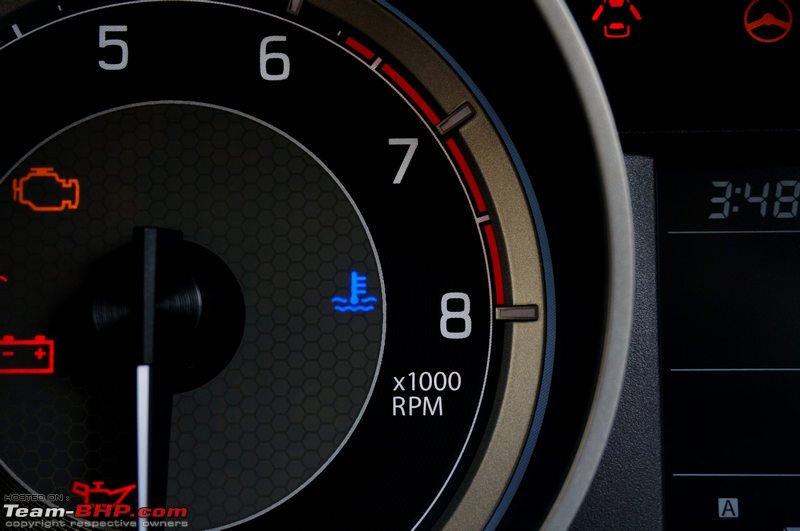 Petrol Dzire doesn't get any sticker (diesel gets one). Be sure to specify the type of fuel to the pump attendant. Black plastic spill protector is provided below the fuel cap:  Yep, the ORVMs are India-friendly and will move the other way if a biker side-swipes them:  Small 37L fuel tank. Maruti should definitely have given a larger tank. The outgoing Dzire had a 42L tank:  Healthy amount of plastic cladding in the front wheel arches...  ...and the rear as well. Looks like the product guys scored over the bean counters on this generation of the Dzire:  Recommended tyre pressure is 29 PSI all-around for both tyre sizes:  Metal plate with VIN & engine number riveted on the B-pillar (driver's side):  Rubber beading is soft and appears well-fitted:  Auto dimming IRVM shockingly missing in an otherwise well-equipped car! Why Maruti, why  ? Why go 95% of the way, and leave the 5% out? Standard manual adjuster is provided: ? Why go 95% of the way, and leave the 5% out? Standard manual adjuster is provided: Interior switches including the start/stop button are backlit in orange:  Neatly integrated solar sensor (for the climate control) sits on the right side of the dashboard:  Light sensor (for the automatic headlamps) is located on the left: 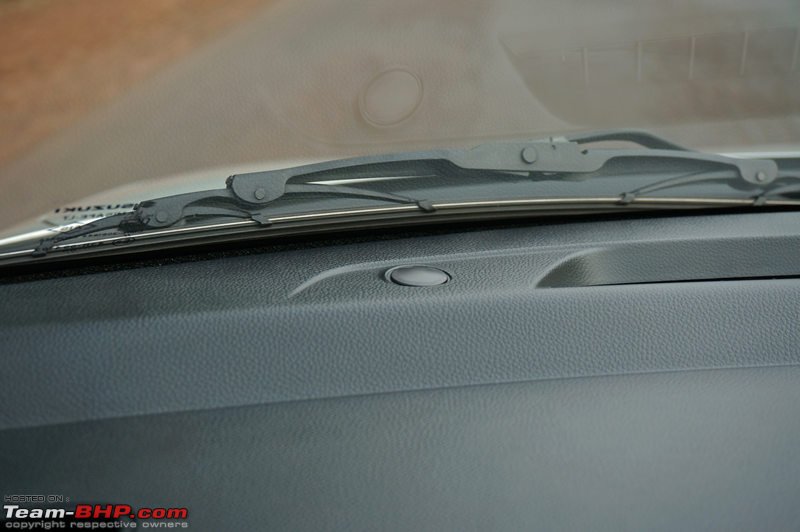 Seatbelt buckle is placed high - even with the driver's seat set at its tallest position. When the seat is set low, it stands out (literally):  Spiral cord with the wire for the seatbelt sensor is clearly visible:  Hooks to lock the floor mat in place only on the driver's side. Warning label in English as well as Hindi:  Basic 'door ajar' warning light doesn't specify which door is open. No display on the MID either:  To enter 'accessory mode', press the engine start button without the clutch (brake in the AMT). This is denoted by a lamp on the instrument cluster:  Both dials of the instrument cluster get this honeycomb detailing:  Finally, Maruti gets a new smartkey design!! The styling & buttons are decidedly less premium than the keyfob of Nexa cars though. Skeleton key inside: 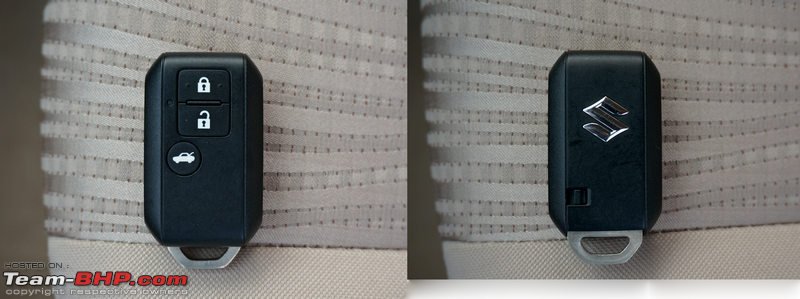 OBD port is located below the dashboard (in the driver footwell):  Red light keeps blinking when the car is locked, indicating that the security system is armed:  Horn discs are located right in the front. The tone is neutral-sounding, but not as sweet as the wind-tone units of European cars:  Last edited by GTO : 11th July 2017 at 09:56. |
| |  (31)
Thanks (31)
Thanks
 |
| The following 31 BHPians Thank Aditya for this useful post: | arvind71181, AutoIndian, Avikbrio, blackwasp, CarguyNish, deetjohn, dkaile, dZired, espraveen, Gannu_1, GTO, HighwayHopper, InControl, Jaggu, Karthik Chandra, Keynote, libranof1987, Nohonking, NPV, phoenixash, PraNeel, Rambo-RS, RavenAvi, samabhi, silverado, Simhi, theexperthand, TorqueTwist, uday.ere, vaasu, vb-saan |
| |
| | #12 |
| Team-BHP Support  | A peek inside the Dzire's factory 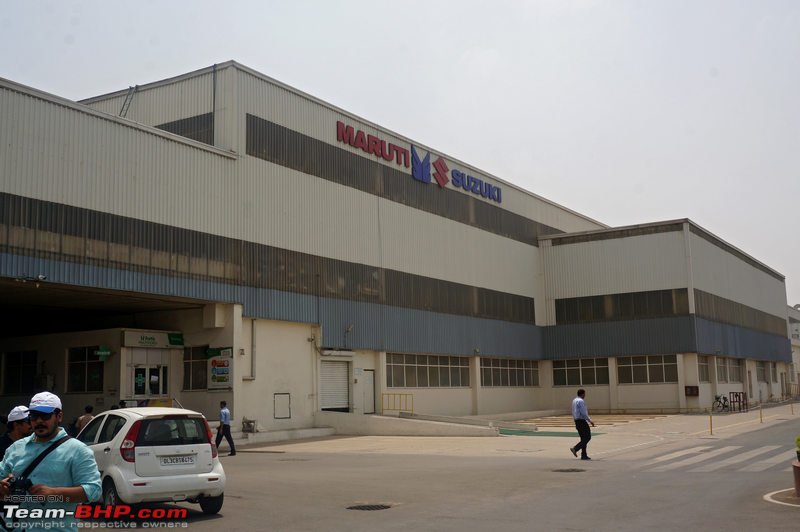 Maruti Suzuki has two factories in Haryana - Gurgaon & Manesar which, on a daily basis, roll out 2,700 and 3,100 vehicles respectively. Collectively, these factories produce 16 models and 1,075 variants, working in 2 shifts of 8 hours each. Both the plants have two pre-decided shutdowns of one week each in the year (every six months) for scheduled maintenance. About 10% of the total number of cars produced is exported to 110+ countries. Maruti invited Team-BHP for a short tour of the Manesar facility. It is spread over 600 acres and houses 3 fully-integrated plants (A, B & C). The facility employs 7,000 personnel and more than 1,100 robots. For the Dzire, Maruti has installed 104 new high speed C-series robots. They are 15% faster in operation than the earlier B-series robots. The plant uses automation comparable to that used in Suzuki's Japanese plants. We visited Plant A, where the Dzire is made. The Swift and Ciaz are built here as well. This plant consists of a press shop, weld shop, paint shop, assembly line and vehicle inspection area. The various processes of this plant have already been covered in an excellent detailed report by Flying Spur. The production line can accommodate various models. It has multi-model welding capacity, dual stamping in the press shop and can produce similar and dissimilar panels simultaneously in one stroke. Other features include turn table mechanisms, consolidation of platforms and automatic change of robot hands. The plant has the ability to paint 48 colours. The HEARTECT platform which underpins the new Dzire:  104 new high speed C-series robots have been installed for the Dzire:  The finished panels from the press shop come together to form a car body frame in the weld shop. Think of all four doors, the hood, trunk, roof, floor and frame panels coming together to be welded and forming a single car shell:  The shop is 100% automated. The weld line does not have any workers operating machines or the panels, just some overseeing and supervising the process for compliance. The machines are sensor-based, and read the PSN (production sequence number) to recognize the model + correspondingly the job at hand (they weld the spots accordingly):  After the weld shop has finished its work, the bodyshell is transported to the paint shop:  The painted body enters the assembly line where parts such as the headlamps and tail-lamps go on. Each part is clearly marked:  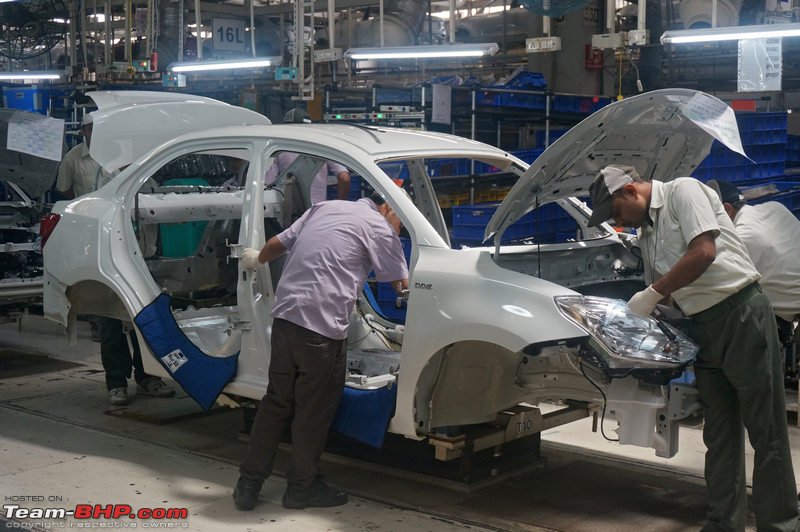 The dashboard is fitted:  Each time a worker picks up a part, he has to tug at the colour-coded ball to register it in the system:  The assembly line uses 'Pika Pika' - a foolproof process under which, an alarm rings and the production line stops moving forward if a wrong part is lifted by a worker. The system also specifies (in red) the part that is wrongly picked:  The marriage where the engine and front axle are fitted onto the body structure. The rear axle has already been fitted:   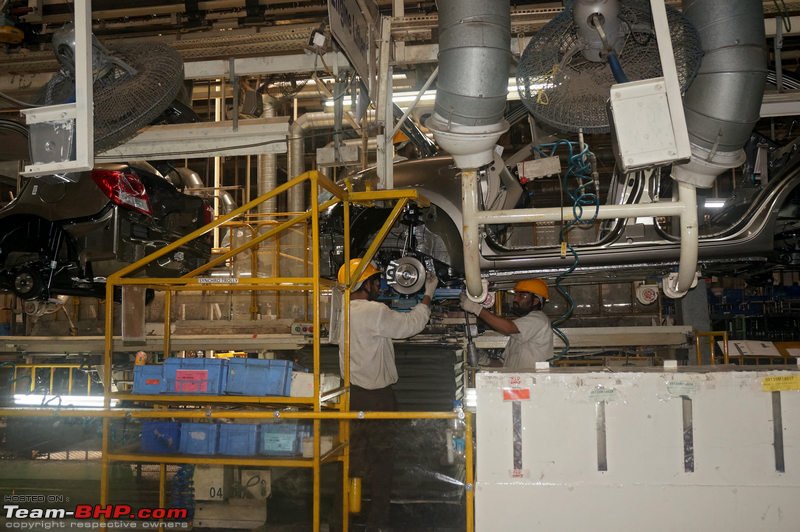 A number of tests are performed before the cars are signed off on. These include electrical component testing...  ...underbody inspection...  ...and engine + transmission on the dyno:  Last edited by Aditya : 11th July 2017 at 07:55. |
| |  (67)
Thanks (67)
Thanks
 |
| The following 67 BHPians Thank Aditya for this useful post: | a*ed, aabhimanyu04, abhinav.s, Added_flavor, Aficionados, amitpunjani, AutoIndian, Avikbrio, blackwasp, CarguyNish, deetjohn, Dennis, dkaile, Dr.Naren, drive_angry, dZired, gabrielthomas, ganeshb, Gannu_1, GTO, HappyRoadie, heavenlybull, hemanth.anand, InControl, IndigoXLGrandDi, Jaggu, jphukan, Karthik Chandra, Leoshashi, libranof1987, Lobogris, mmmjgm, mpksuhas, mustang_shelby, nikipedia87, Nohonking, NPV, nsbhagwat, phoenixash, Ponbaarathi, pranavGTI, PraNeel, procrj, RavenAvi, Reinhard, Safari_Beast, sairamboko, sathyasuri, Simhi, Sisu, Skyline_GT, sumeethaldankar, TaurusAl, TejasKinger, The Rationalist, theexperthand, thegodfr, TorqueTwist, Transporter, uday.ere, vaasu, vb-saan, Vid6639, Viju, Vik0728, Vitalstatistiks, VWAllstar |
| | #13 |
| Team-BHP Support  | Re: Maruti Dzire : Official Review Thread moved from the Assembly Line to the Official Reviews Section. Thanks for sharing & rating a full 5 stars! |
| |  (2)
Thanks (2)
Thanks
 |
| The following 2 BHPians Thank GTO for this useful post: | Aditya, uday.ere |
| | #14 |
| Team-BHP Support  | Re: Maruti Dzire : Official Review Often, we say that - - i20 is a better buy than Xcent - Jazz is a better buy than Amaze - Baleno is a better buy than the old 2nd gen Swift dZire. Does the equation change now? Is the new 3rd gen dZire a better buy than the Baleno? |
| |  (5)
Thanks (5)
Thanks
 |
| The following 5 BHPians Thank SmartCat for this useful post: | Aditya, sumeethaldankar, Sunrock, turbospooler, Vitalstatistiks |
| | #15 | |
| BHPian Join Date: Sep 2014 Location: Noida
Posts: 332
Thanked: 617 Times
| Quote:
-more features model for model - much more cohesive design -nexa premium network -exhibited by more waiting period for a 1.5 year model -superior Automatic transmission -preference for Nexa customers in service centers -sub 4m sedans have come a long way in terms of design, but have a long way to go | |
| |  (7)
Thanks (7)
Thanks
 |
| The following 7 BHPians Thank dhruvritzed for this useful post: | Aditya, AkMar, Avikbrio, carmayogi, deetjohn, InControl, SmartCat |
 |



